
A digital tool kit for integrating theater arts into
standards-based curriculum, featuring:
• Historical Background
• Production Notes
• Artists’ Insights
• Suggested Lessons
• Student Activities
• Links to Rich Media
• Resource Directory
StageNotes Producer’s Edition
STUDY
GUIDE

Stacey Mindich
Mickey Liddell Hunter Arnold Caiola Productions Double Gemini Productions
Fakston Productions Roy Furman Harris Karma Productions
On Your Marks Group Darren Bagert Roger & William Berlind
Bob Boyett Colin Callender Caitlin Clements Freddy DeMann Dante Di Loreto
Bonnie & Kenneth Feld FickStern Productions Eric & Marsi Gardiner Robert Greenblatt
Jere Harris and Darren DeVerna The John Gore Organization Mike Kriak Arielle Tepper Madover
David Mirvish Eva Price Zeilinger Productions Adam Zotovich Ambassador Theatre Group
Independent Presenters Network
AND The Shubert Organization
EXECUTIVE PRODUCERS
Wendy Orshan and Jeffrey M. Wilson
IN ASSOCIATION WITH
Arena Stage Second Stage Theatre
Molly Smith, Edgar Dobie Carole Rothman, Casey Reitz
BOOK BY MUSIC AND LYRICS BY
STEVEN LEVENSON BENJ PASEK & JUSTIN PAUL
SCENIC DESIGN BY PROJECTION DESIGN BY COSTUME DESIGN BY LIGHTING DESIGN BY SOUND DESIGN BY
DAVID KORINS PETER NIGRINI EMILY REBHOLZ JAPHY WEIDEMAN NEVIN STEINBERG
VOCAL ARRANGEMENTS &
HAIR DESIGNER MUSIC DIRECTOR MUSIC COORDINATORS ADDITIONAL ARRANGEMENTS BY
DAVID BRIAN BEN COHN MICHAEL KELLER JUSTIN PAUL
BROWN MICHAEL AARONS
ADVERTISING PRESS REPRESENTATIVE DIGITAL MARKETING MARKETING PARTNERSHIPS
SERINO COYNE DKC/O&M SITUATION INTERACTIVE ROSE POLIDORO
CASTING BY PRODUCTION MANAGEMENT PRODUCTION STAGE MANAGER COMPANY MANAGER
TARA RUBIN CASTING JUNIPER STREET JUDITH SCHOENFELD KATRINA ELLIOTT
LINDSAY LEVINE, C.S.A. PRODUCTIONS
ASSOCIATE DIRECTOR ASSOCIATE PRODUCERS GENERAL MANAGER
ADRIENNE CAMPBELL-HOLT JAYNE HONG 101 PRODUCTIONS LTD.
RACHEL WEINSTEIN
MUSIC SUPERVISION, ORCHESTRATIONS
& ADDITIONAL ARRANGEMENTS BY
ALEX LACAMOIRE
CHOREOGRAPHY BY
DANNY MEFFORD
DIRECTED BY
MICHAEL GREIF
Originally presented by Arena Stage – July 9, 2015 to August 23, 2015
New York premiere at Second Stage – March 26, 2016 to May 29, 2016
Original Cast Recording Available on Atlantic Records.

Dear Evan Hansen,
Today is going to be a great day, and here’s why:
Dozens of schools have booked tickets for your show. Just imagine
how thrilling it will be to welcome thousands of students
–
their
teachers and parents
–
to Broadway’s Music Box Theatre, and to
theaters presenting the tour across the country. We know that
your story will resonate with them, as it is so apropos to teenage
life today, and hopefully, by sharing your story, you will inspire
them to reflect upon and share their own.
We want them to make the most of their theater experience, so
we’ve created this study guide to give them a glimpse into your
world and how it was created, as well as to provide teachers with
follow-up activities and discussion prompts for the classroom. We
realize that each classroom is unique, so we hope that teachers will
feel free to pick and choose the sections that are most relevant
and appropriate for their students and curriculum. So as not to
leave out the adults, we’ve also included a page for parents and
teachers with links to articles that relate to many of the topics
and themes covered in your show.
So, get ready, Evan. The students are coming with their
exuberance and energy, and they eagerly await your story.
It’s time to step into the sun....
Sincerely,
Me
DEAR EVAN HANSEN
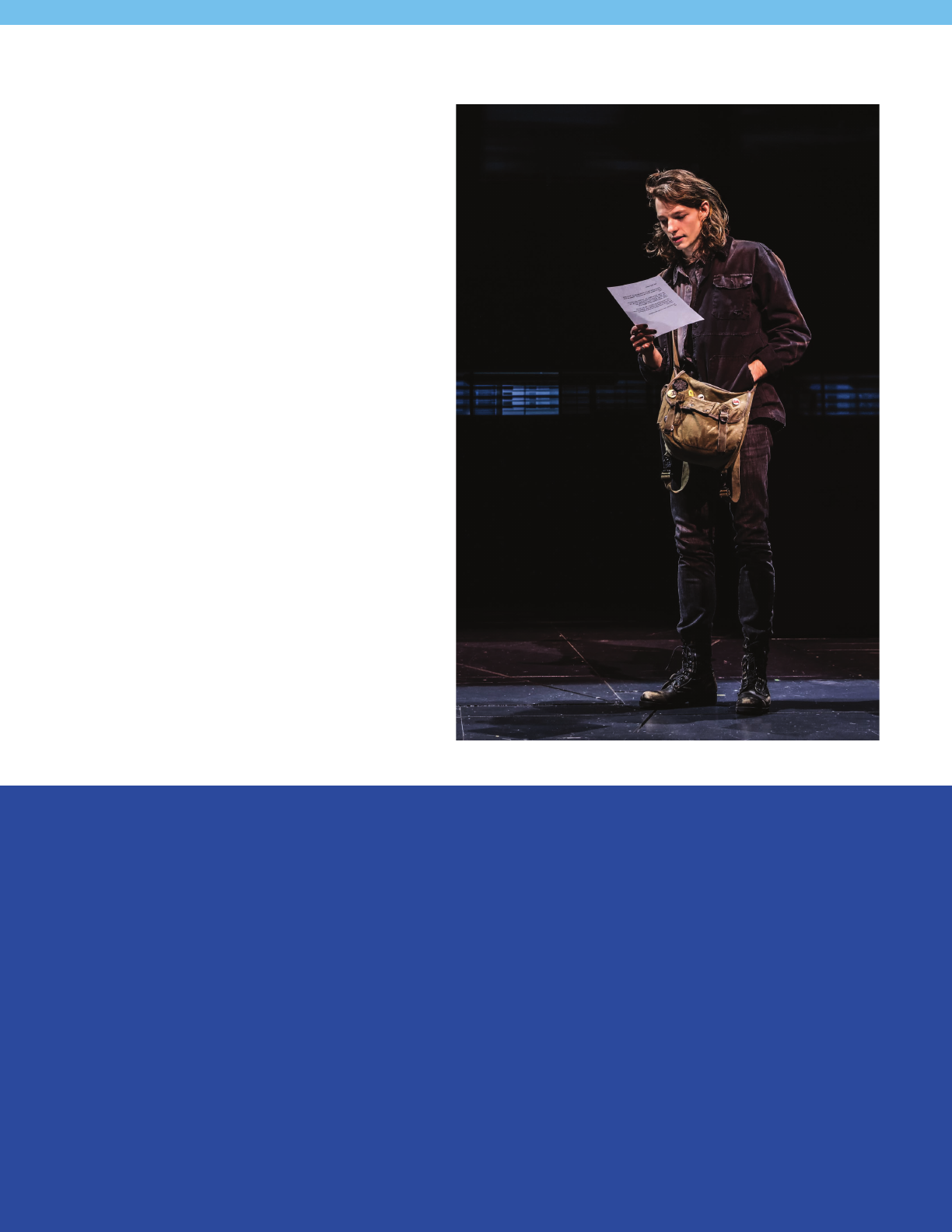
TABLE OF CONTENTS
A LETTER THAT WAS NEVER
MEANT TO BE SEEN, A
LIE THAT WAS NEVER
MEANT TO BE TOLD, A
LIFE HE NEVER DREAMED
HE COULD HAVE. EVAN
HANSEN IS ABOUT TO
GET THE ONE THING
HE’S ALWAYS WANTED: A
CHANCE TO FINALLY FIT IN.
Both deeply personal
and profoundly
contemporary,
Dear
Evan Hansen
is a new
American musical
about life and the way
we live it.
4
Mike Faist as Connor Murphy (Original Broadway Cast)
Introduction . . . . . . . . . . . . . . . . . . . . . . . . . . . . . . . . . .4
Cast of Characters. . . . . . . . . . . . . . . . . . . . . . . . . . . . .5
Musical Numbers . . . . . . . . . . . . . . . . . . . . . . . . . . . . . . 5
The Journey to Broadway. . . . . . . . . . . . . . . . . . . . .6–7
In Conversation with Steven Levenson. . . . . . . . . . . .8
Composing with Pasek & Paul . . . . . . . . . . . . . . . . 9–10
Direction from Michael Greif . . . . . . . . . . . . . . . . . . . 11
On Movement from Danny Mefford . . . . . . . . . . . . . . 11
Making Music by Alex Lacamoire . . . . . . . . . . . . . . .12
Eye for Scenery by David Korins . . . . . . . . . . . . . . . . 13
Focus on Projection by Peter Nigrini . . . . . . . . . . . .14
Costuming Today by Emily Rebholz . . . . . . . . . . . . .15
Spotlight on Ben Platt . . . . . . . . . . . . . . . . . . . . . . . . . 16
Consider Music . . . . . . . . . . . . . . . . . . . . . . . . . . . . . . 17
Analyze Choices . . . . . . . . . . . . . . . . . . . . . . . . . . . . .18
Reect on Social Media . . . . . . . . . . . . . . . . . . . . . . .19
Compare Music & Lyrics . . . . . . . . . . . . . . . . . . . . . . . 20
Examine Songs . . . . . . . . . . . . . . . . . . . . . . . . . . . . . .21
Discuss Scene Dialogue . . . . . . . . . . . . . . . . . . . . . . . 22
Evan & Connor, Act II . . . . . . . . . . . . . . . . . . . . . . . . .23
Take Action & Be Creative . . . . . . . . . . . . . . . . . . . . .24
Empower: Inside Post It Forward . . . . . . . . . . . . . . . . 25
Write to Inspire . . . . . . . . . . . . . . . . . . . . . . . . . . . . . .26
Understanding Social Anxiety . . . . . . . . . . . . . . . . . .27
Don’t Be Afraid to Ask for Help . . . . . . . . . . . . . . . . .28
Help a Friend in Need . . . . . . . . . . . . . . . . . . . . . .29–31
Resources for Teachers & Parents . . . . . . . . . . . . . .32
Education Standards for Lessons . . . . . . . . . . . . . . . 33
Production Resources . . . . . . . . . . . . . . . . . . . . . . . .34

Evan Hansen (17) Smart, sincere, and cripplingly
self-conscious, Evan prefers to hover in the background, a
supporting player in his own life, too afraid to step forward into the
spotlight and risk ridicule or, what might be worse, no one noticing
him at all.
Heidi Hansen (40s) Evan’s mother. Overworked
and stretched too thin, Heidi loves her son ercely, but fears they
have begun to grow apart. She is prepared to do anything to repair
the damage.
Zoe Murphy (16) Sensitive and sophisticated, Zoe
couldn’t care less about the status games and popularity rites of
high school. Funny and bright, she feels a terrible ambivalence
about her brother’s death, nding it difcult to forgive him for all he
did, and forgive the part of herself that nds relief in the fact that
he’s gone.
Connor Murphy (17) An angry, disaffected
loner, Connor has been a troubled kid for as long as anyone can
remember, an enigma and a source of endless consternation to his
long-suffering parents and sister.
Cynthia Murphy (40s) Connor and Zoe’s mother.
To E va n, sh e se em s to b e th e pe rf ec t mo th er, nu rt ur in g, a va il ab le ,
and willing to talk about anything. To her own children, it’s a bit
more complicated.
Larry Murphy (40s) Connor and Zoe’s father.
Though often tense and taciturn, Larry shows a different face to
the world, representing for Evan the dad he always wished for:
strong, condent, and, more than anything, reliable, someone to be
counted on.
Jared Kleinman (17) Droll and sarcastic,
Jared claims to be forced by his parents to hang out with family
friend Evan, for whom he ostensibly has nothing but disdain.
Jared covers his own obvious insecurities with a well-practiced
braggadocio and a know-it-all arrogance.
Alana Beck (17) Alana is an incredibly genuine
person. Everything she does comes from a place of deep
honesty and tremendous feeling. All of the characters in
this musical put up masks of sorts. For Alana, it’s a façade
of cheerfulness. She is always ready with a smile, a note of
encouragement. This hides the loneliness underneath.
CAST OF CHARACTERS
ACT I
“Anybody Have a Map?” . . . . . . Heidi, Cynthia
“Waving Through a Window” . . Evan, Company
“For Forever” . . . . . . . . . . . . . . . . Evan
“Sincerely, Me” . . . . . . . . . . . . . Connor, Evan, Jared
“Requiem.” . . . . . . . . . . . . . . . . . Zoe, Larry, Cynthia
“If I Could Tell Her” . . . . . . . . . . . Evan, Zoe
“Disappear” . . . . . . . . . . . . . . . Connor, Evan, Alana,
Jared, Cynthia, Larry,
Zoe
“You Will Be Found” . . . . . . . . . Evan, Company
ACT II
“Sincerely, Me” (Reprise) . . . . .Connor, Jared
“To Break in a Glove” . . . . . . . . Larry, Evan
“Only Us” . . . . . . . . . . . . . . . . . . Zoe, Evan
“Good for You” . . . . . . . . . . . . . Heidi, Alana,
Jared, Evan
“You Will Be Found” . . . . . . . . . Company
(Reprise)
“Words Fail” . . . . . . . . . . . . . . . Evan
“So Big/So Small” . . . . . . . . . . . Heidi
“Finale” . . . . . . . . . . . . . . . . . . Company
MUSICAL NUMBERS
To listen to the Dear Evan Hansen Original Broadway Cast Recording, explore character-inspired
playlists and more, visit the Dear Evan Hansen artist prole on Spotify. Have you created a show-
inspired playlist of your own? Share it with us @DearEvanHansen.
5
FROM THE NOTEBOOK OF BOOK WRITER STEVEN LEVENSON

6
THE JOURNEY TO BROADWAY
MAY 2014, DEVELOPMENTAL READING
JULY 2014, DEVELOPMENTAL READING
MAY 2016
OCTOBER 2016
OCTOBER 2016
NOVEMBER 2016
MAY 2016
SEPTEMBER 2014
DEVELOPMENTAL READING
NOVEMBER 2014
FEBRUARY 13, 2015
JULY 25, 2015
@BenSPLATT
Say what you want about it, but in my
opinion, there’s nothing as exciting and
awe-inspiring as a really good piece of new
musical theatre.
@pasekandpaul
Cooking up something new this week
@benjpasek
Today was one of those
creatively fullling days
that can come once
in a decade. Inspired
& buzzing from being
around such wonderful
people
@LacketyLac
Planting
some seeds
@benjpasek
Excited to announce our new (&
1st original) musical DEAR EVAN
HANSEN is premiering in DC this
summer at @arenastage!
pasekandpaul
At the rst day
of rehearsal
for Dear Evan
Hansen in DC!
#tbt since this
pic was taken...
yesterday! :)
@DearEvanHansen
Broadway performances
begin in Nov!
bensplatt
We did @dearevanhansen for
300 high school kids and it was
THRILLING Y’ALL.
@DearEvanHansen
“This is the dream. This is what I’ve
been dreaming about my whole life.”
@pasekandpaul #FirstRehearsal
@DavidKorins
These 2 superstars
checking in (bright &
early) on load in of
@dearevanhansen
at #TheMusicBox.
@pasekandpaul
First preview for Dear
Evan Hansen on
Broadway is tonight!
Here. We. Go.
#DearEvanHansen
DEMO RECORDING
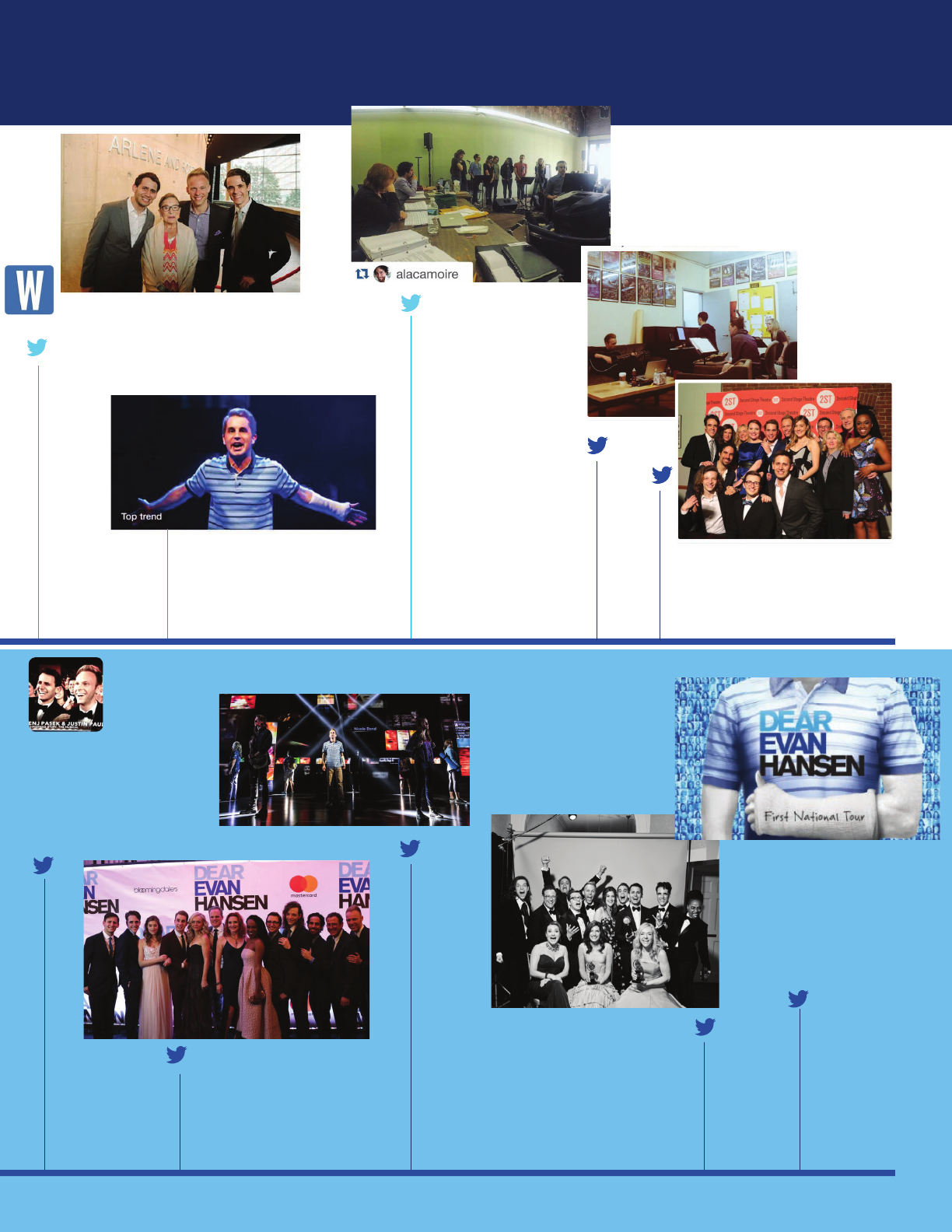
7
NOVEMBER 2016
DECEMBER 4, 2016
FEBRUARY 13, 2017
JUNE 12, 1017
SEPTEMBER 7 2017
AUGUST 2015
AUGUST 2015
MARCH 20, 2016
@washingtonian
The Notorious RBG showed up at the
premiere of @arenastage’s
@DearEvanHansen.
Dear Evan Hansen
Dear Evan Hansen Will
Shuttle from D.C. to Off-
Broadway’s Second…
Just Started Trending
@pasekandpaul
The one and only
@LacketyLac
CRUSHING the
orchestrations for
#dearevanhansen at
today’s sitzprobe!!!
@pasekandpaul
It’s happening!
@DearEvanHansen
will record a cast
album released on
Atlantic Records!
@DearEvanHansen
A huge congratulations
to our #DearEvanHansen
family on a successful
#openingnight!
@TheaterMania
@DearEvanHansen
makes highest-charting
@billboard debut of a
cast album since 1961
@The Tony Awards
@DearEvanHansen accepts
a #TonyAward2017 for Best
Musical.
@DearEvanHansen
we nally get to meet
out friends across the
country as #DEHtour
begins October on its
way to more than 50
cities.
TOP TREND
MARCH 2016
@pasekandpaul
New songs are brewing at
#dearevanhansen rehearsals
@2STNYC w/@rachelbayjones and
@JLTsayswhat! #whoisevanhansen
MAY 2016, OPENING
NIGHT OFF-BROADWAY
@DearEvanHansen
Congratulations to the entire
#DearEvanHansen at @2stnyc
family! Now it’s time to celebrate!

IN CONVERSATION WITH STEVEN LEVENSON
8
Steven Levenson is a
celebrated playwright, and a
2017 Tony Award winner for
writing the book for
Dear Evan Hansen.
ON THE ROLE OF A BOOK
WRITER
In the case of the musical,
as a book writer, your job in
a lot of cases is to support
the score and to make sure
the most important moments
emotionally are happening in
song. So, it’s a lot of guring out when to step out of the way, and
to make sure that you’ve laid the ground enough — and not too
much — so that those characters can make the leap into song.
ON CREATING A NEW MUSICAL
In a way, there’s a great freedom about [creating an original
work]. We are not beholden to any preexisting vision, but with that
freedom comes a lot of anxiety — because we can do anything
we want. That can be both freeing and terrifying. [As told to The
Washington Times]
ON COLLABORATING WITH BENJ PASEK AND JUSTIN PAUL
I think the role of the book writer can be very different things. In
this case, since there was no source material, it was really the
three of us coming up with this idea together. We started with
this idea of “connection” — people’s desire and thirst and need
for connection. My instinct was to create a story about someone
who could not connect in a world that is all about connection and
interconnectedness. What does it mean to have a protagonist
who is somehow unable to connect? So slowly, Evan began to
take shape.
It seemed like the best idea was for me to just write the story
like it was a play, because we didn’t have anything else to go
on. So I started writing the rst act. Where we had talked about
possibly placing songs, I would leave space in the script. I
would either have nothing or I would have a long monologue
— a soliloquy, really — with a character diving into his thoughts
to suggest what was happening emotionally. That’s how it all
started, with this rst draft.
From there, Benj and Justin started writing songs, but there was a
lot of back and forth and rewriting. It was an endless dialogue —
two steps forward and one step back — because you are building
this thing together. It’s a little bit chicken and the egg. You have
to be constantly making it and remaking it to accommodate one
another — always in service to the story.
ON WRITING PLAYS VERSUS MUSICALS
It’s so different in so many ways. The big obvious difference is that
it’s collaborative from the start — and that your vision is not the only
vision. It’s about nding a shared vision with your collaborators. You
want to be a little bit hidden in the background at times — you want
the music to be the star and the music to do the heavy lifting. So it’s
a lot of cutting the things you love the most, and allowing the ideas
that you have or the dialogue that you’ve written to become a song.
It’s actually really amazing, though, because it feels like something
that you just had in your head becomes three dimensional in a way
that you could never imagine.
ON SOCIAL MEDIA AS A CHARACTER IN THE SHOW
We knew we wanted to tell a contemporary story that’s set today,
and we knew that we had to somehow talk about social media. I
compare it to Bye Bye Birdie, when they’re using the telephones
in “The Telephone Hour.” It’s like they’re not using the telephones
to talk about telephones, they’re using them because that’s how
their world functions. And if we tried to tell our story today without
cell phones and social media, there would be a real inauthenticity
about the show. And at the same time we wanted to be sure we’re
using social media as a storytelling device and we were never
interested in exploring social media as a theme or as an idea. We
always wanted to make sure it was grounded in the story and part
of the grammar of the show. [As told to Broadway Direct]
ON CREATING TWO VERY DIFFERENT FAMILIES FOR
DEAR EVAN HANSEN
Both families really came into focus as the story itself took shape.
Larry and Cynthia Murphy, we knew, had to represent everything
that Evan’s own splintered family wasn’t, his fantasy of what two
stable and emotionally available parents might look like. As with
all fantasies, Evan’s rose-colored vision of the Murphys turns out
to have a tenuous relationship to the reality underneath, but that
discovery will only come later for him. In contrast to this ostensibly
perfect family, Evan’s mother, Heidi Hansen, strives to be what her
son needs her to be, but everything she does seems only to push
him further away. The most important thing for us, in creating these
characters, was to present them honestly and without judgment:
three parents striving in their own awed and imperfect way to do
what’s best for their children.
Original Source Material:
DiLella, Frank. “Dear Evan Hansen: A Contemporary Musical for All Ages.”
BroadwayDirect.com, November 1, 2016.
Leslie, Emily. “Levenson’s Dear Evan Hansen Opens at Arena Stage.” The
Washington Times, July 7, 2015.
STEVEN LEVENSON (Book) Author of The Unavoidable
Disappearance of Tom Durnin (Roundabout Theatre Company,
Outer Critics Circle Award), Core Values (Ars Nova, Drama
Desk nomination), Seven Minutes in Heaven (Colt Coeur), The
Language of Trees (Roundabout), and the book for Dear Evan
Hansen (Second Stage; Obie, Outer Critics Circle Awards for Best
Musical and Best Book of a Musical; Arena Stage, Helen Hayes
Award). His plays are published by Dramatists Play Service and
Playscripts. A graduate of Brown University and former artist in
residence at Ars Nova, he is a founding member of Colt Coeur
and an alumnus of MCC’s Playwrights Coalition.
Steven Levenson
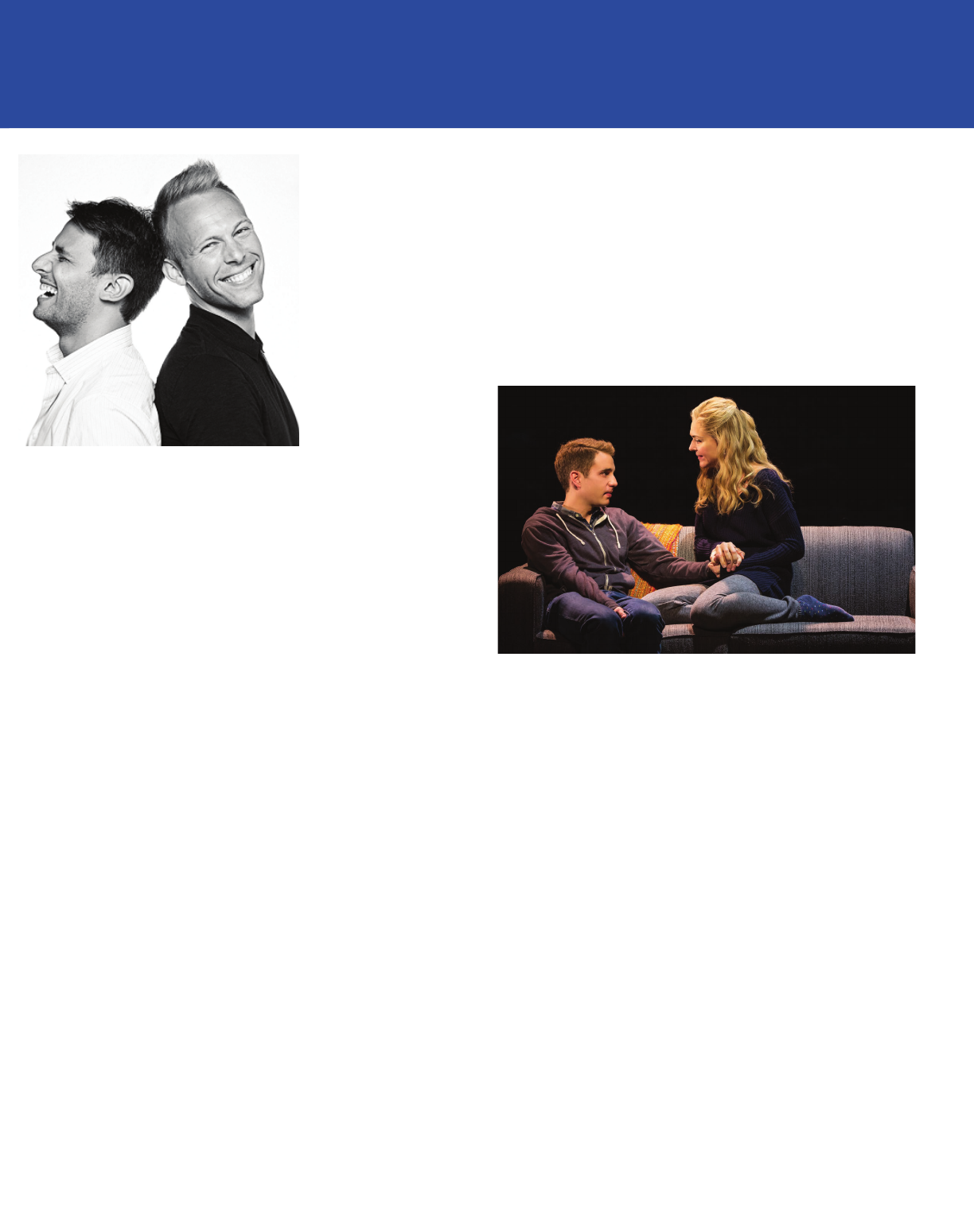
9
This Tony Award-winning
pair have worked
together as a dynamic
musical duo since
their college days — a
partnership that has
taken them to Broadway,
Hollywood, and beyond.
At the same time that
they were developing
Dear Evan Hansen,
Pasek and Paul were
also writing lyrics for the
award-winning film La
La Land, which earned
them a Golden Globe
®
and Academy Award
®
for
Best Original Song.
Here, the two talk about how their collaboration began and
how they brought their original musical to life.
How did you become a composing team?
BP: We both went to the University of Michigan for musical
theater. We went there to be actors. For a lot of people who
love the theater, when you’re young, acting is your way in. But
halfway through school we realized maybe we’re not cut out
to be performers.… After many failed attempts to get good
roles in our school shows, we saw the writing on the wall and
thought, “Why don’t we write our own show, and see what we
can make of that?” [As told to Metro Weekly]
JP: We just started doing it for fun. We were freshmen in college
when we began tinkering. It was fun to develop songs thinking
from characters’ perspectives. We decided to string some of these
songs together and make a song cycle our sophomore year.
People were receptive. I think before we even knew what was
happening we had begun a collaboration. [As told to Metro Weekly]
What role did music play in your childhood?
JP: I grew up in a pretty musical household. Neither of my
parents are professional musicians, but they’re very, very
musical. My dad and my mom would sit down and play the
piano. I grew up playing a lot of music in church, and singing
with my parents. I started taking piano lessons when I was 7.
So they were always very encouraging and they knew that I
had a love for it and a knack for it. [As told to Metro Weekly]
In addition to being a performer, I always wanted to be in the
pit orchestra, playing piano or percussion. I always saw myself
being involved on the musical side of things in musical theater.
I just gured it would be interpreting and teaching and working
out other people’s music. I hadn’t really planned on it being my
own music. [As told to Metro Weekly]
BP: My mom created a bunch of kids’ albums where she
would document whatever we were doing growing up and she
would turn those moments into songs. She had a children’s
music group in our local area of Philadelphia. So I grew up just
witnessing my mom, who’s a psychologist — not a professional
musician — turning life moments into song. That’s essentially
what we do every day, when we try to create theater. Watching
her interpret things that were happening in the world, or in my
world as a kid, and setting them to music — I think that really
sparked an interest in writing and creating and interpreting life
moments into song lyrics. [As told to Metro Weekly]
Facebook and YouTube were instrumental in circulating
your early music. Can you elaborate on the role the
Internet played in launching your career?
JP: For us, in terms of songwriting, having our stuff out
online was a huge way to be able to connect with people, and
musical theater fans all over the country and all over the world,
in a way that couldn’t have happened 20 years ago. People
knew our songs and knew our music before we ever had a
show in New York City.
BP: In terms of our careers, I think we were in the right
place at the right time, and started writing songs at the right
time. We were in college in 2005 and that was a year after
Facebook began. And the year that YouTube began. And I
think that really changed the way that people had access to
new material.
BP: Before that, shows needed to exist in New York — you
needed at least an Off-Off-Broadway production to spread
the word. What was so revolutionary about Facebook and
YouTube was this democratization of who could have access
to putting stuff online, and being able to see it right away. So,
you could be in Iowa or Singapore and you could see your
content immediately without having to go to New York. And as
COMPOSING WITH PASE K & PAU L
Ben Platt as Evan Hansen with Rachel Bay Jones as Heidi
Hansen, his mother (Original Broadway Cast).
Benj Pasek and Justin Paul

writers, we didn’t have to go through any traditional means of
getting it out there [through agents or producers] — we just put
it online. [As told to TCG]
Tell us a bit about how the idea for Dear Evan Hansen
originated. I understand that it was born out of your own
high school experience.
BP: There was a student who was sort of anonymous. He
died of a drug overdose, and it was sort of unclear whether it
was intentional or not. After he passed away the student body
became very, very close to him. Everybody sort of claimed
him as their best friend after he died, and began to write
their college essays about him, and began to talk about how
amazing he was and how important he was in their lives. [As
told to Metro Weekly]
When Justin and I met in college, and we began to write
musicals, this moment from my high school days continued to
be fascinating. We talked about exploring it in a musical. Since
then, we’ve brought up a lot of other themes that we wanted to
talk about — there’s sort of a need to connect, the need to be
part of a community, the need to be a part of something larger
than yourself, especially in the digital, isolated age that we
now nd ourselves in. We began to explore how we could take
those themes and turn them into a musical. And that’s when the
amazing Steven Levenson came into the picture and helped us
to churn our ideas into an actual plot. [As told to Metro Weekly]
JP: We noticed certain things about our culture … some
things that were fascinating about the modern response
to tragedy and loss. We became very interested in the
world’s response to loss. And how people grieve and also
communicate in the era of social media.
JP: It made us think about our desire to connect, and our
desire to be a part of something larger than ourselves. Despite
our great connectedness through Facebook and Twitter and all
of these social media platforms, despite being as connected
as we’ve ever been as a society …
BP: We’re more isolated than ever. All of us, teenagers and
adults alike.
JP: And so we wanted to use that as the backdrop of our
story, but we’re telling it through the specic story of a family.
This family is looking for that kind of connection, and in losing
someone they love, they try to ll that void.
Can you talk a bit about the character of Evan Hansen? He
is a risky, unusual protagonist.
JP: It’s denitely an unusual one in that he’s riddled with
issues and anxieties, and with lots of self-esteem issues
and a lot of other things. But I think that’s what makes him
very accessible and identiable and relatable. Hopefully
everyone can go and see the show and see a little bit of Evan
in themselves, and feel like they can connect with him, or at
least connect with the situations that he nds himself in — he
doesn’t know the right thing to say to people, or how to t into
a conversation, or how to be himself and not try to create or
embellish a story about himself that is better than what he thinks
his real life is. It’s a different sort
of character and maybe not your
typical musical theater leading man,
but that’s denitely what we were
hoping to write — a contemporary
and relevant and accessible
character. [As told to Metro Weekly]
BP: Traditionally, in Musical Theater
101, you learn to try to write a protagonist who people like
and root for on their journey. In Dear Evan Hansen, we have a
protagonist who does things that are really morally questionable.
It’s our jobs as writers to try to get the audience to identify with
him and to support why he does what he does. We wanted
to try to a create character who was more complex — and
more nuanced — than maybe more traditional musical theater
characters. We’ll let critics and audiences be the judge of whether
or not we have succeeded or failed. [As told to Metro Weekly]
Original Source Material:
Rule, Doug. “Perfectly Composed: Pasek and Paul are the future of the
American musical.” MetroWeekly.com, August 13, 2015.
Evans, Suzy. “You Tubesicals: The Internet Is Reinventing How Musical
Theatre Is Distributed and Licensed — and Even How Shows Are Being
Written.” American Theatre, Highbeam.com, July 1, 2014.
10
COMPOSING WITH PASE K & PAU L
Watch Benj Pasek
and Justin Paul’s
TEDxBroadway discussing
art, artists, and the age of
YouTube composers, from
April 20, 2015.
BENJ PASEK AND JUSTIN PAUL (Music and Lyrics) are
the Tony, Oscar and Golden Globe-winning
songwriting team behind Dear Evan Hansen. Other
Broadway: A Christmas Story, The Musical (Tony, Drama
Desk, Outer Critics Circle nominations). Off-Broadway: Dear
Evan Hansen (Second Stage; Obie Award, Drama Desk
Award, Outer Critics Circle Award); Dogght (Second Stage;
Lucille Lortel Award and Drama League, Outer Critics
Circle, London Evening Standard Award nominations).
Regional: James and the Giant Peach (Seattle Children’s
Theatre) and Edges (Capital Repertory Theatre). Film:
The Greatest Showman, La La Land, Trolls, Snow White.
Tel e v is i o n: “S m a sh , ” “ T he Fla s h. ” Ad d i ti o na l ho n or s : R i cha r d
Rodgers Award for Musical Theatre (American Academy of
Arts and Letters), ASCAP Richard Rodgers New Horizons
Award, Jonathan Larson Award. Both are graduates of
the University of Michigan Musical Theatre Program and
members of the Dramatists Guild of America, Inc.

11
Q: Dear Evan Hansen marks
the eighth original musical you
have directed, including your
award-winning productions of
Rent, Next to Normal, and Grey
Gardens. Can you talk a bit about
the process of developing a new
musical? What drew you to this
project in particular?
A: What drew me to the piece initially was the opportunity to
work with these collaborators, who I thought were exciting, and
young, and very interesting theater makers. And then, when I
rst heard about what the piece was, I was very drawn to the
complicated and emotional lives of the characters. I really thought
that Benj, Justin, and Steven were creating a piece where the
characters … had very good reasons to express themselves
through song and music. In such a heightened emotional arena
it … the stakes are so high that it feels like the characters are
singing for their lives. [As told to Playbill.com]
Q: How would you describe the story of Evan Hansen?
A: It’s a really truthful, smart, and sophisticated story about
how 17-year-olds live in the world today … and about how
parents relate to their children and how kids relate to their
parents.... [It’s] about a lonely kid, and how a family in crisis, a
grieving family, in many ways adopts this lonely kid. And this
kid nds a lot of love and a lot of support from this family, but
also always knows that in many ways he doesn’t deserve their
love and support. At the same time the family is dealing with
an extraordinary loss. And … they really make this kid a part
of their family because they need this kid to be a part of their
family. It fullls an enormous need that they’re suffering from
— to have a surrogate son. [As told to Playbill.com]
Q: What message would you like for people to take away
from Dear Evan Hansen?
A: That everybody deserves a chance. And everybody
deserves a second chance.
Original Source Material:
Rothstein, Mervyn. “Next to Normal’s Michael Greif Stirs Up More Family
Drama with Dear Evan Hansen.” Playbill.com, July 6, 2015.
MICHAEL GREIF (Director) Broadway credits: Rent, Grey
Gardens, Next to Normal, (Tony noms.); Never Gonna Dance;
If/Then, War Paint. Recent work includes A Parallelogram
(Second Stage), Our Lady of Kibeho and Angels in America
(NY’s Signature Theatre); The Intelligent Homosexual’s
Guide… (Public); and The Tempest, A Winter’s Tale and
Romeo and Juliet at The Public’s Delacorte Theater. Off-
Broadway, he’s received Obie Awards for Machinal, Dogeaters
(Public) and Rent (NYTW), and has directed new plays and
musicals at Playwrights Horizons, Roundabout, MTC, MCC,
New York Theatre Workshop and at Second Stage, where he
directed Next to Normal and Dear Evan Hansen. Regional
work includes premieres and revivals at Williamstown Theatre
Festival (ten seasons), La Jolla Playhouse (AD, ve seasons),
Arena Stage, Center Stage, Mark Taper Forum, Dallas Theater
Center, Trinity Repertory Company. Greif holds a BS from
Northwestern University and an MFA from the University of
California, San Diego.
DANNY MEFFORD (Choreographer) Broadway: Fun Home, Bloody Bloody Andrew Jackson,
The Bridges of Madison County. Other New York: Love’s Labour’s Lost, The Good Person
of Szechwan, Much Ado About Nothing, Pump Boys and Dinettes for City Center Encores!,
Melancholy Play, Dance Dance Revolution. Other: The Sound of Music (U.S. tour), Miss You
Like Hell (La Jolla Playhouse). Directing: Becoming Liv Ullmann (NY Fringe), Wasted (Ars
Nova), The Maids. Drama Desk, and Lortel and Astaire Award nominee for choreography.
MFA from Brown University, BS from the University of Evansville.
DIRECTION FROM MICHAEL GREIF
ON MOVEMENT FROM DANNY MEFFORD
My ideology is that everything that happens on stage
should ow from the story. If you are thinking about
the why they are dancing rather than just enjoying the
moment, I haven’t done my job correctly. It should seem
the actors have no choice but to dance. —Danny Mefford
Michael Greif
Danny Mefford

Q: What exactly is
the role of the musical
supervisor and how
do you work with the
composers to deliver
the musical elements
of the show?
A: The actual job of
the music supervisor
is to oversee all of the
music in the show.
I teach music to the
actors. I work as a liaison
between the composer
and the actors so if the
composer wants to
have a phrase sung a
certain way or a song to be interpreted in a certain way, he will
tell me and I will tell the actors and/or the music director. All
musicals need a music director, but not all shows have a music
supervisor. A music director, in our case, is the person who is
actually conducting eight shows a week, playing piano, leading
the band. As music supervisor, I have global supervision
without having to be at the theatre for every performance.
As music supervisor I also work with the band to give them
notes about how I think the music should be interpreted. I
also work with the sound designer and give him notes about
balance — “For this song I need the acoustic guitar to be softer,
and for this other song I would love for you to play with the
amount of reverb you have on the singer’s voice.” I also work
with the director of the show, Michael Greif. He will give me
notes about certain things that he sees, like if he thinks that
something isn’t sounding clear or if there’s an issue of musical
timing. It’s my job to actually gure out how to help music time
out with the lights and time out with the scene so that it feels
right and organic and it is to the director’s wishes.
So it’s a lot of servicing. I cater to the director. I cater to the
composer. I try to make the actors feel comfortable. And that is
what I do just as a music supervisor without even discussing
the fact that I’m also the orchestrator!
Q: Tell us about your role as orchestrator.
A: The job of an orchestrator is to actually write down what
every individual instrument in the orchestra plays.
As an orchestrator, it was my job to decide what I thought was
the best number of musicians to have in the band for Dear Evan
Hansen, which has eight players. And then it was my job to
actually write out what we call “charts” — the sheet music for
the band. So, for example, if I want the strings to play a chord,
I have to sit down and gure out, “OK, the violin plays this note,
the cello plays that note, and the viola plays this note, and the
three of them together make this chord.” I make decisions about
what instruments play at any given time, because you don’t want
to have all eight instruments playing every second of the show
— you need to use different colors at different moments. For
example: The guitarist doesn’t play just one type of guitar; he has
an electric guitar and a steel-string guitar. It’s my job to decide
which of those instruments he plays in any moment based on
what I think sounds best for that song. I could have also asked
for other guitars, like a mandolin or a nylon-string acoustic, but
I didn’t think those were the right avors to have in the score.
Same thing for the bass player: He has an electric bass and an
acoustic bass and I have to decide which of those two he’s going
to use for which song, and when he’s playing the acoustic bass
I decide if he should use the bow to play it or does he use his
ngers to pluck it. I have to make those decisions and actually
write that down for every bar of music in the show.
Q: That’s incredible because, when the composers give
it to you, it might only be the piano part.
A: That’s exactly right. A composer might hear in his head what
he wants, but he might not have the technique or the vocabulary
to make it happen. So I’m a translator in that respect.
Q: You have experienced hearing loss since you were a
child. How has this impairment affected your music and
the work you do as musical supervisor?
A: My hearing loss probably makes me listen a little harder,
makes me listen a little more closely to music. It’s hard for me to
hear someone when they are talking from far away, so because
of that it allows me to live in my own bubble. I think that actually
developed a lot of focus for me, because I can really zero in on
music and just tune out the world and everything around me.
Maybe because of the fact that I have to work to listen, it makes
me really get into ner details of music that by now are very
second nature to me. I often wonder, Is my handicap actually an
asset? [As told to the Miami Herald]
Frias, Carlos. “How a Miami musician overcame hearing loss to help create
the music to Hamilton.” MiamiHerald.com, October 13, 2016.
MAKING MUSIC BY ALEX LACAMOIRE
Alex Lacamoire
Alex Lacamoire (Music Supervisor/Orchestrator) is a
three-time Tony and two-time Grammy winner for his work
on Dear Evan Hansen, Hamilton and In the Heights. As
music director, arranger and/or orchestrator: Annie (2011
B’way revival), Bring It On, The People in the Picture, 9 to
5 (Drama Desk and Grammy noms.), Legally Blonde, High
Fidelity, Wicked, Bat Boy, Godspell (2001 national tour).
He is an Emmy-nominated composer for “Sesame Street.”
12

“ Every design process has
many steps — there is research
involved, and ground plans,
renderings, and models — but
what was unique about the Dear
Evan Hansen process was that
I had an immediate visceral,
emotional response to what I
was seeing and hearing. I was
trying to maintain this idea of
people oating through a void,
on tectonic plates of life with
their own internal monologues
and their own emotional space,
while at the same time trying to
connect to each other and the
world around them.”
—David Korins
EYE FOR SCENERY BY DAVID KORINS
DAVID KORINS (Scenic Design) Broadway:
Hamilton (Tony nom.), Bandstand, War Paint (Tony
nom.), Misery, Motown, Vanya and Sonia…, Annie,
Bring It On, Magic/Bird, An Evening With Patti
LuPone and Mandy Patinkin, Godspell, Chinglish,
The Pee-wee Herman Show, Lombardi, Passing
Strange and Bridge and Tunnel. TV: “Grease:
Live!” (Emmy Award). Concert: Bruno Mars, Lady
Gaga, Kanye West, Sia, Mariah Carey, Andrea
Boccelli. Extensive Off-Broadway, regional theatre,
hospitality, event and experience design.
The evolution of David Korins’s scenic design for Dear Evan
Hansen from concept to full production on stage at the Music Box
Theatre on Broadway.
David Korins’ initial sketch for the Dear Evan Hansen set.
David Korins
13
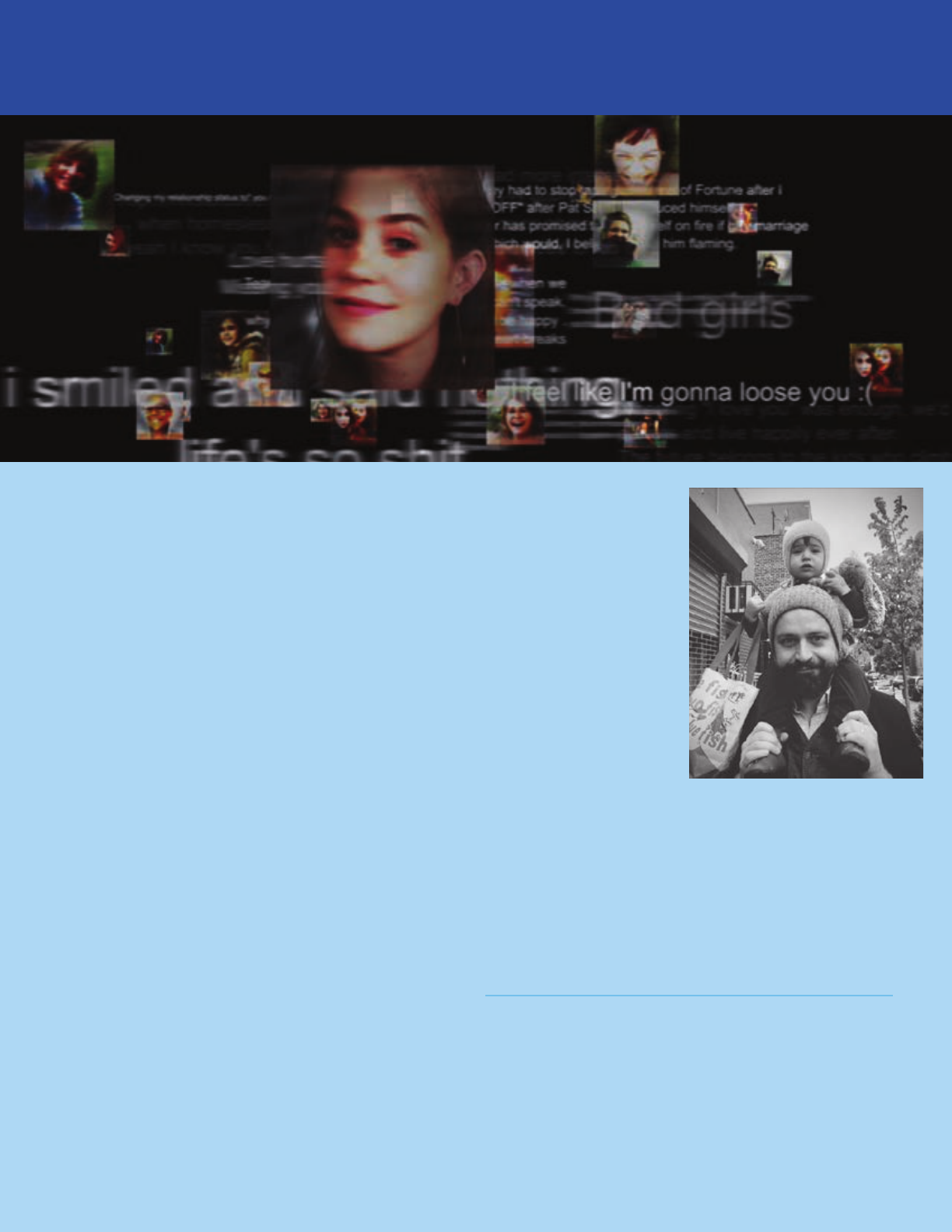
FOCUS ON PROJECTION BY PETER NIGRINI
Peter Nigrin (Projection Design) Broadway: SpongeBob
SquarePants, Amelie, An Act of God, The Heidi Chronicles, The
Best Man, Fela!, 9 to 5. Elsewhere: The SpongeBob Musical
(Chicago), Grounded and Here Lies Love (Public Theater), Far
From Heaven (Playwrights), Notes From Underground (TFNA),
Grace Jones Hurricane Tour, Don Giovanni (Santa Fe), Blind
Date (Bill T. Jones). For Nature Theater of Oklahoma: No Dice
and Life & Times (Burgtheater, Vienna), Monsoon Wedding
(Berkeley Rep), The Skin of Our Teeth (TFNA).
Peter Nigrini
14
Q: Can you talk a bit about the role of projections in the
show?
A: From the beginning of my involvement, which was shortly
after the script and score were solidied and really before
there was an idea of what the whole physical production would
become, the basic question revolved around the fact that so
much of this story is about the way our characters interact
with an online community, with social media, with people who
maybe are not communicating face to face, but rather via
Facebook and Snapchat and various social media platforms.
So Michael Greif asked me, “How do we put that community
on stage and how do we represent them theatrically?” That
was the challenge — how to breathe life into this online world,
which is often very difcult to portray onstage, and how to do
that theatrically. That was the most important part. How do we
both show those interactions but keep them poetic and lyrical?
The same way that emotion is lifted by song, we needed to
take what are often rather mundane interactions, like looking
at our Facebook feed on our cell phones, and make that into
something theatrical.
Q: What is your process for building the projections?
A: The design process really started with coming up with a
visual style and visual metaphor for how we wanted to present
this information. So, long before we ever knew what David
Korins was going to design for the set, there was this question
of coming up with the style, coming up with a language for
how image would be used and how it would move. So that’s
very abstract. That’s about looking at art and other images
and resources and trying to capture the feeling of the show.
After that’s done, it’s then about how we implement that style.
A major part of the design comes from social media and
using fragments of images that are part of social media. In a
way, all of the images in the
production are also drawn
from that. So even in the
situations where what we’re
trying to do is ultimately
set a scene, like in the
Murphys’ living room, the
way we are manifesting that
onstage is by actually using
fragments of images you
might believe are snapshots
that someone took of the
Murphys’ Thanksgiving
dinner, for example. Then
from that we’re taking tiny
little fragments of those
photographs and piecing
together almost a memory
what the Murphys’ living
room might have been. So what that means is that the entire
design is constructed out of tiny, tiny, little fragments of images
that we’ve gathered from anywhere and everywhere so that
the design is made up of over 1,000 images, and each of
those is carefully processed and stitched together into this sort
of collage that is the overall look of the show.

COSTUMING TODAY BY EMILY REBHOLZ
PETER NIGRINI
“ Footwear or something like that,
especially for guys, it tells a lot
about someone: where they shop,
what they want to project, what
clique they’re in. Especially with
teenagers, there’s so much about
image and what you’re putting
forward.”
“ I build a closet for each character
and try out different options
depending on the set and lights.
But that L.L. Bean polo for Evan
was never in question. It’s an iconic
piece of clothing … a safe choice
for a teenager who is just trying to
blend into the background.”
— Emily Rebholz
EMILY REBHOLZ (Costume Design) Broadway: Indecent,
Oh, Hello; If/Then; Vanya and Sonia and Masha and Spike;
Bloody Bloody Andrew Jackson. Select Off-Broadway: Indecent
(Vineyard Theatre); All the Ways to Say I Love You (MCC);
Dear Evan Hansen, The Way We Get By (Second Stage); The
Robber Bridegroom (Henry Hewes Design Award nomination,
Roundabout); The Tempest (Shakespeare in the Park). Recent
designs include Don Giovanni (Santa Fe Opera), La Bohème
(Opera Theatre of St. Louis), Another Word for Beauty (Goodman
Theater) and Disney’s Freaky Friday (Signature Theatre). MFA,
Yale University.
Emily Rebholz’s creative concept for the Dear Evan Hansen costumes.
Emily Rebholz
15
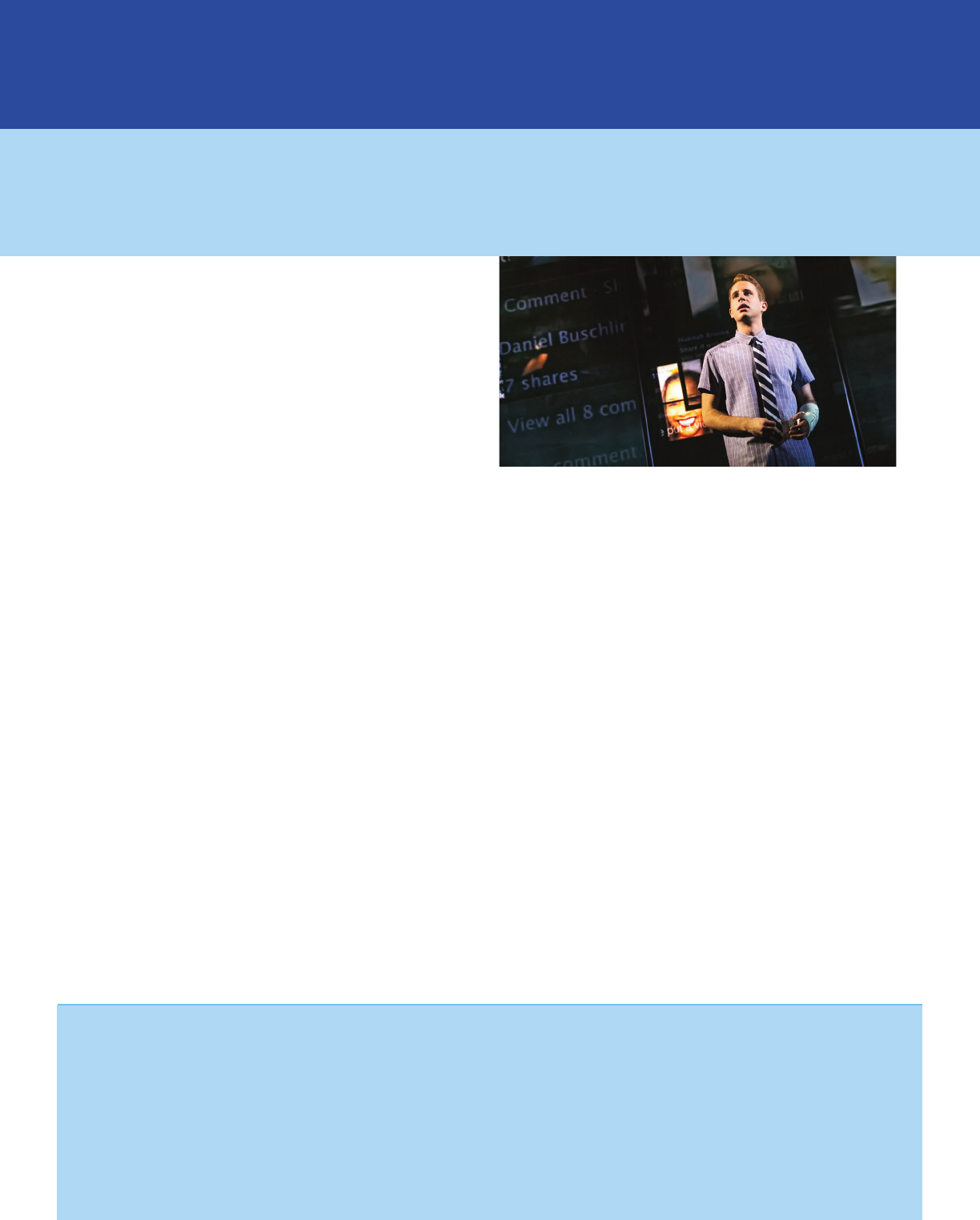
Q: How much do you identify with the character of Evan
Hansen?
A: I can certainly relate to the feeling of wanting to be part of
something and to be sort of accepted. I think everybody kind of
has that in them. I would consider myself a little bit more socially
sufcient in terms of my ability to speak to people. I had to base
his social awkwardness more on people I’ve encountered in my
life, the way that I may feel in certain situations, and how I might
manifest my anxiety were I not better at keeping it squelched,
because I do have my fair share of anxiety. I come from a big
Jewish family and we all have our neuroses and our anxieties. And
I’ve denitely had experiences in the past having to deal with that in
terms of therapy and that sort of thing. [As told to Metro Weekly]
Q: Is playing this emotionally charged role exhausting?
A: Yes, it’s certa inly draining. And I do have to give all of myself
during those two hours. But it’s really a joy to feel like you’re using
everything at your disposal and all the tools in your box. I’ve had
a lot of experience in the preceding years playing characters
who are very marginalized and specic. Of course, I’ve loved
all the projects that I’ve been able to work on, but in doing them
for so long it can get exhausting because you’re using the same
facilities over and over again. Whereas with Evan, while it may be
draining night to night, it’s just incredibly fullling. I can experience
the full range of emotions, use all the parts of my voice, use my
whole body, and live a whole story. [As told to Metro Weekly]
Q: Evan is not your typical protagonist. He makes some
ethically questionable choices, and yet you manage to
somehow keep us on his side.
A: That was denitely the danger and the fear of the creative
team. He makes a lot of morally ambiguous choices, and this
is the hero of the story. And he’s not always doing necessarily
what’s right. I think the reason it’s so successful is because they
make sure that you are fully aware of what Evan is thinking at all
times and what his intentions are in every moment. I feel like
if there was ever a moment where you feel like you couldn’t
really see inside him, you may not necessarily stay with him or
stay on his side. So the fact that it’s written so fully from Evan’s
perspective, and that you really feel like you know this kid, helps
you to stay with him. [As told to Metro Weekly]
Q: In Dear Evan Hansen, something goes “viral” that
shouldn’t have necessarily gone viral. Do you ever worry
about what you put out on social media?
A: It’s always scary, especially with all the Pitch Perfect stuff. I keep
gaining followers, and it’s becoming a bigger thing. When I rst
started on Twitter, I was in high school, and it was just my Twitter. I
would say funny things and talk to my friends, and now it’s this big
platform where I need to say politically correct things and promote
things. It’s scary because anything you post on there or on Instagram
is in the world forever. You can never take it back, so you have to
be really careful, and you have to take things in stride and not take
comments and criticisms too seriously. Just be condent in what you
want to share. [As told to TCG American Theatre Magazine]
Evans, Suzy. “Ben Platt Goes From Nerd to Leading Man in Dear Evan Hansen”.
AmericanTheatre.org. Theatre Communications Group. June 17, 2015.
Rule, Doug. “New plateau: Ben Platt’s pitch perfect rise to stardom.”
MetroWeekly.com. August 13, 2015.
SPOTLIGHT ON BEN PLATT
(EVAN HANSEN – ORIGINAL BROADWAY CAST)
FOLLOWING PERFORMANCES RANGING FROM AWKWARD MAGICIAN BENJI APPLEBAUM
IN
PITCH PERFECT
TO NERDY SIDEKICK ELDER CUNNINGHAM IN
THE BOOK OF
MORMON
, BEN PLATT STEPPED INTO THE SPOTLIGHT WHEN HE ORIGINATED THE TITLE
ROLE IN
DEAR EVAN HANSEN
ON BROADWAY
BEN PLATT (Evan Hansen) won the 2017 Tony Award for Best
Leading Actor in a Musical and the Drama League’s Distinguished
Performance Award for his portrayal of Evan Hansen after
creating the role at Arena Stage in Washington, D.C. and Off-
Broadway at Second Stage Theatre (Lucille Lortel Award, Obie
Award, Clarence Derwent Award, Outer Critics Circle and Drama
League nominations). Platt was the original Elder Cunningham
in the Chicago production of The Book of Mormon and reprised
the role on Broadway. National tours: Caroline, or Change (dir.
George C. Wolfe). Regional credits include The Black Suits
(Barrington Stage Company), The Power of Duff (New York Stage
and Film), Dead End (dir. Nicholas Martin, Ahmanson Theatre).
Concerts: I’m Here (solo show, 54 Below sold out engagement),
The Secret Garden (25th anniversary). Film: Benji Applebaum in
Universal Pictures’ smash hits Pitch Perfect and Pitch Perfect 2,
Ricki and the Flash (dir. Jonathan Demme, starring Meryl Streep),
Billy Lynn’s Long Halftime Walk (dir. Ang Lee). Upcoming: Drunk
Parents, The Female Brain.
Ben Platt as Evan Hansen (Original Broadway Cast)
16

SPOTLIGHT ON BEN PLATT
(EVAN HANSEN – ORIGINAL BROADWAY CAST)
17
Every protagonist makes choices that inform his or her
journey — and sometimes the journey of others. Some
are proactive choices, others reactive. Some are carefully
considered, others impulsive. Some are clear cut, but more
often than not, debatable.
DISCUSS:
Discuss Evan’s choices throughout the musical and in
particular his decision to lie to the Murphy family about having
known Connor. How does the lie begin? How does it change?
What is Evan’s motivation? How does his choice impact the
Murphys? Evan’s mom? His fellow students? What are the
outcomes — both positive and negative? What do you think of
Evan’s choice?
WRITE:
Persuasive Essay:
Is it ever OK to tell a lie?
From a young age, children are taught the negative
implications of lying, but as we grow, sometimes our
perspectives shift. We learn that the morality of lying is not
always black and white and that perhaps there might be times
when it is acceptable — maybe even appropriate — to lie.
Drawing from scenarios in your own life, historical events,
or Evan’s experience, take a position and make your case.
Consider every angle. What might be the benets and the
ramications? Consider short- and long-term implications.
Perspective: Look at it from the other side.
How does it feel to be on the receiving end of a lie? How
might each member of the Murphy family feel about what
Evan has done? And how about Evan’s mom and the added
lies he has told her?
Choose a supporting character from the musical. Write a
journal entry (or song, if you are feeling ambitious!) in his/her
voice, conveying his/her emotions once Evan has revealed
the truth.
MAKING CHOICES
ANALYZE CHOICES
ACTIVITY
The original Broadway company of Dear Evan Hansen.
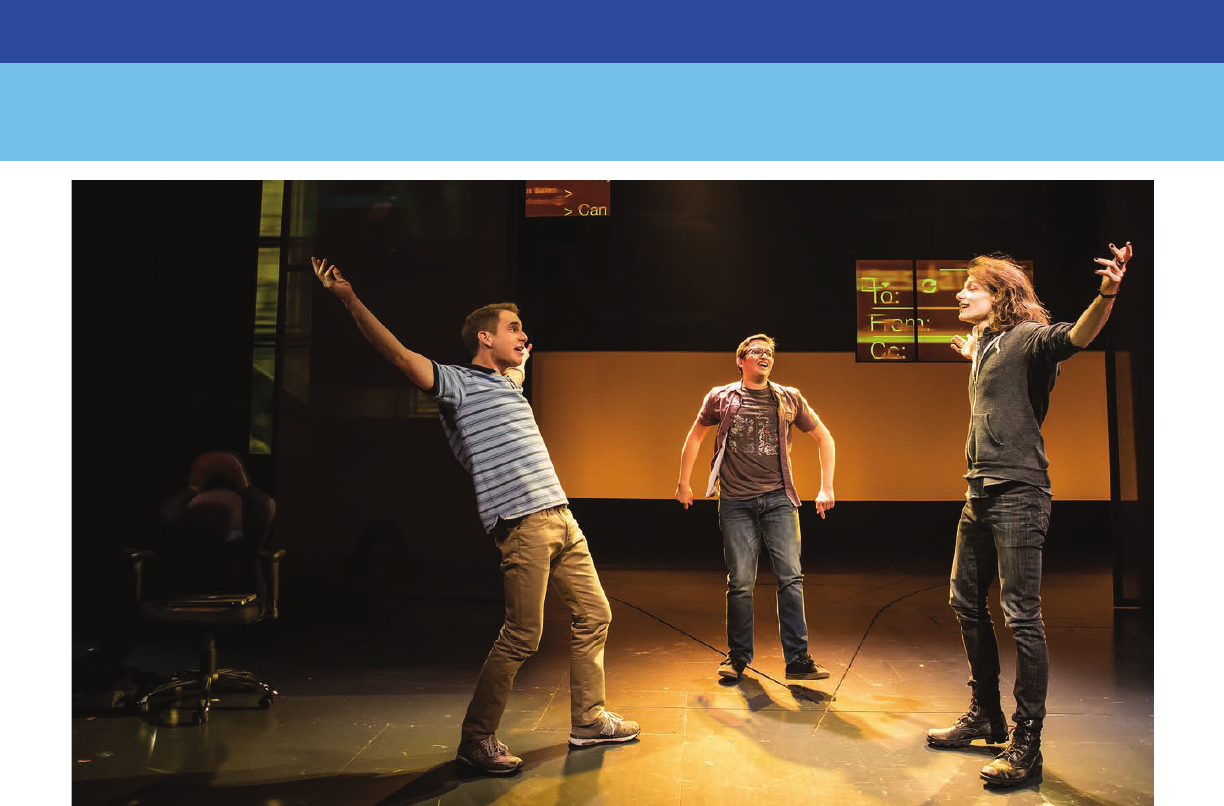
CONSIDER MUSIC
In Dear Evan Hansen, Evan — with the help of his friend Jared — “reinvents” Connor through a series of ctitious emails
detailing their “friendship.” Through this imagined friendship, Evan also begins to reinvent himself. Together in “Sincerely Me”
they sing:
“CAUSE ALL THAT IT TAKES IS A LITTLE REINVENTION
IT’S EASY TO CHANGE IF YOU GIVE IT YOUR ATTENTION
ALL YOU GOTTA DO
IS JUST BELIEVE YOU CAN BE WHO YOU WANNA BE
SINCERELY, ME”
DISCUSS:
Do you think it is possible to “reinvent” yourself — either how you perceive yourself or how others perceive you? How can
believing in yourself help to shape your personal narrative?
18
ACTIVITY
Ben Platt as Evan Hansen, Will Roland as Jared Kleinman, Mike Faist as Connor Murphy (from left) (Original Broadway Cast)
MUSIC
Reinvention: Shaping your own personal narrative

THE DIGITAL EFFECT
Social Media: Catalyst and Accelerator
It happens every day in our modern world. We post a photo, a video,
or a “newsworthy” event to Facebook, Instagram or Twitter and
within seconds the “likes” come pouring in, followed by dozens of
comments and countless re-tweets and shares. Within minutes these
numbers can multiply and within hours they can explode. Before we
know it, that story is trending.
The speed at which information can spread over the Internet is
undeniable.
WRITE: Write an essay discussing the positive and negative
implications of this catalytic impact. How can social media be used to
control the ow of information/mobilize events/shape perceptions and
alternatively how can it spin out of control — taking on a life of its own?
Draw from examples in Dear Evan Hansen, your daily life, and the
world at large.
Your online self: Is it the real you?
Some might say that social media sites offer them a place to share
more of themselves than they might feel comfortable sharing in
real life (IRL). Others might feel pressure to curate the most perfect
version of themselves since it’s so publicly on display.
DISCUSS: How do you feel? Is the persona you project through
social media the real you? Why or why not? Do you behave differently
on different forms of social media? Snapchat, Twitter, Instagram — and
how about on your Finsta account?
A MESSAGE FROM ALIZA
WEINBERGER, AUDIENCE
DEVELOPMENT ASSISTANT
AT MASHABLE
There’s a moment near the
beginning of Dear Evan Hansen
when Alana reprises a few lines
of “Waving Through a Window,“
tapping on the screen of her
phone. The rst time I saw
the show, I immediately fell in
love with that song. But seeing
Alana’s moment hit me hard.
I’ve often been that person
staring into my phone or my laptop screen, wondering if
anyone is listening and convinced no one is. That’s why I,
like so many others, obsess over the number of likes I get on
any given post. That social media engagement validation is
quantiable, immediate, and compelling.
It’s even harder to ignore since getting online engagement is
now my job. I’m a digital content marketer, a job that didn’t exist
when I was in high school, and I’ve been trained to know all the
ways to get as many likes online as possible. Because of that, I
know how arbitrary those likes can be. And just like Evan’s viral
speech, what goes online is rarely the full story.
The Internet is a complex place. Terrible things can happen
there, like bullying, no privacy, and miscommunication. You
can waste so much time scrolling through other people’s
Instagram photos or swiping through Snapchat stories and
imagining their lives are better than yours. But the Internet is
also pretty amazing. I wouldn’t work with it otherwise. You can
connect with people around the world, nding new friends
you’d never have met. You can learn almost anything, and
you can never really be bored. It can be a real force for good,
when channeled the right way. The fans who contributed to
#YouWillBeFound are proof of that.
Spending my work days glued to my screens has made me
take a hard look at how social media impacts my life, the
good and the bad. People talk about not wanting to bring their
work home, but I always seem to have my personal accounts
open when I’m out with friends or see something Snapchat-
worthy while out and about. Unplugging is hard, but it’s a
good idea. Taking the time to breathe and reevaluate, to
remember what you love about your social media and what
you want to come back to, is a great idea. Evan would take
a break to hang around some trees, whereas I prefer taking
walks around New York or reading a book. No matter what
you do, screen-free time doesn’t need to be a punishment or
a chore.
The Internet, and social media, is a tool; it’s not good or bad.
But what you do there can be either. It helps to take a step
back and see. Stop waving through that window and stop to
decide if you really wanted that view in the rst place.
19
Ben Platt with Jennifer Laura Thompson and Michael Park as
Mrs. and Mr. Murphy (Original Broadway Cast)
REFLECT ON SOCIAL MEDIA
ACTIVITY
For Common Core State Standards see page 33.
CONSIDER MUSIC

20
MUSIC/LYRICS
What role do the songs play in a musical?
Songs have a dramatic function that are an integral part of
the storytelling: They help to develop character and/or move
the action of the plot forward.
In musicals, it is a general rule that characters break into
song when the emotional stakes have become so high
that ordinary speech fails them. Through their songs, the
characters can reveal their innermost thoughts, fears,
hopes, and dreams, grapple with difficult decisions, and
come to important realizations about themselves.
Musical theater lyrics use many poetic devises, including
rhythm, rhyme, repetition, figurative language, symbolism,
and metaphor.
WAVING THROUGH A WINDOW
I’VE LEARNED TO SLAM ON THE BRAKE
BEFORE I EVEN TURN THE KEY
BEFORE I MAKE THE MISTAKE
BEFORE I LEAD WITH THE WORST OF ME
GIVE THEM NO REASON TO STARE
NO SLIPPIN’ UP IF YOU SLIP AWAY
SO I GO NOTHIN’ TO SHARE
NO, I GOT NOTHIN’ TO SAY
STEP OUT, STEP OUTTA THE SUN
IF YOU KEEP GETTIN’ BURNED
STEP OUT, STEP OUTTA THE SUN
BECAUSE YOU’VE LEARNED, BECAUSE YOU’VE LEARNED
ON THE OUTSIDE ALWAYS LOOKIN’ IN
WILL I EVER BE MORE THAN I’VE ALWAYS BEEN?
’CAUSE I’M TAP-TAP-TAPPIN’ ON THE GLASS
WAVING THROUGH A WINDOW
I TRY TO SPEAK BUT NOBODY CAN HEAR
SO I WAIT AROUND FOR AN ANSWER TO APPEAR
WHILE I’M WATCH-WATCH-WATCHIN’ PEOPLE PASS
WAVING THROUGH A WINDOW
OH
CAN ANYBODY SEE?
IS ANYBODY WAVING BACK AT ME?
WE START WITH STARS IN OUR EYES
WE START BELIEVIN’ THAT WE BELONG
BUT EV’RY SUN DOESN’T RISE
AND NO ONE TELLS YOU WHERE YOU WENT WRONG
STEP OUT, STEP OUTTA THE SUN
IF YOU KEEP GETTIN’ BURNED
STEP OUT, STEP OUTTA THE SUN
BECAUSE YOU’VE LEARNED, BECAUSE YOU’VE LEARNED
ON THE OUTSIDE ALWAYS LOOKIN’ IN
WILL I EVER BE MORE THAN I’VE ALWAYS BEEN?
’CAUSE I’M TAP-TAP-TAPPIN’ ON THE GLASS
WAVING THROUGH A WINDOW
I TRY TO SPEAK BUT NOBODY CAN HEAR
SO I WAIT AROUND FOR AN ANSWER TO APPEAR
WHILE I’M WATCH-WATCH-WATCHIN’ PEOPLE PASS
WAVING THROUGH A WINDOW
OH
CAN ANYBODY SEE?
IS ANYBODY WAVING…?
WHEN YOU’RE FALLIN’ IN A FOREST
AND THERE’S NOBODY AROUND
DO YOU EVER REALLY CRASH
OR EVEN MAKE A SOUND? (4X)
DID I EVEN MAKE A SOUND?
DID I EVEN MAKE A SOUND?
IT’S LIKE I NEVER MADE A SOUND
WILL I EVER MAKE A SOUND?
ON THE OUTSIDE ALWAYS LOOKIN’ IN
WILL I EVER BE MORE THAN I’VE ALWAYS BEEN?
’CAUSE I’M TAP-TAP-TAPPIN’ ON THE GLASS
WAVING THROUGH A WINDOW
I TRY TO SPEAK BUT NOBODY CAN HEAR
SO I WAIT AROUND FOR AN ANSWER TO APPEAR
WHILE I’M WATCH-WATCH-WATCHIN’ PEOPLE PASS
WAVING THROUGH A WINDOW
OH
CAN ANYBODY SEE?
IS ANYBODY WAVING BACK AT ME?
IS ANYBODY WAVING
WAVING
WAVING
OH
OH
LY R I C AN A LYS I S
WRITE: Read the lyrics of “Waving Through a Window.” Write an essay exploring how Pasek and Paul use gurative
language to reinforce the isolation and insecurity that Evan feels at the beginning of the musical.
COMPARE MUSIC & LYRICS
ACTIVITY
For Common Core State Standards see page 33.
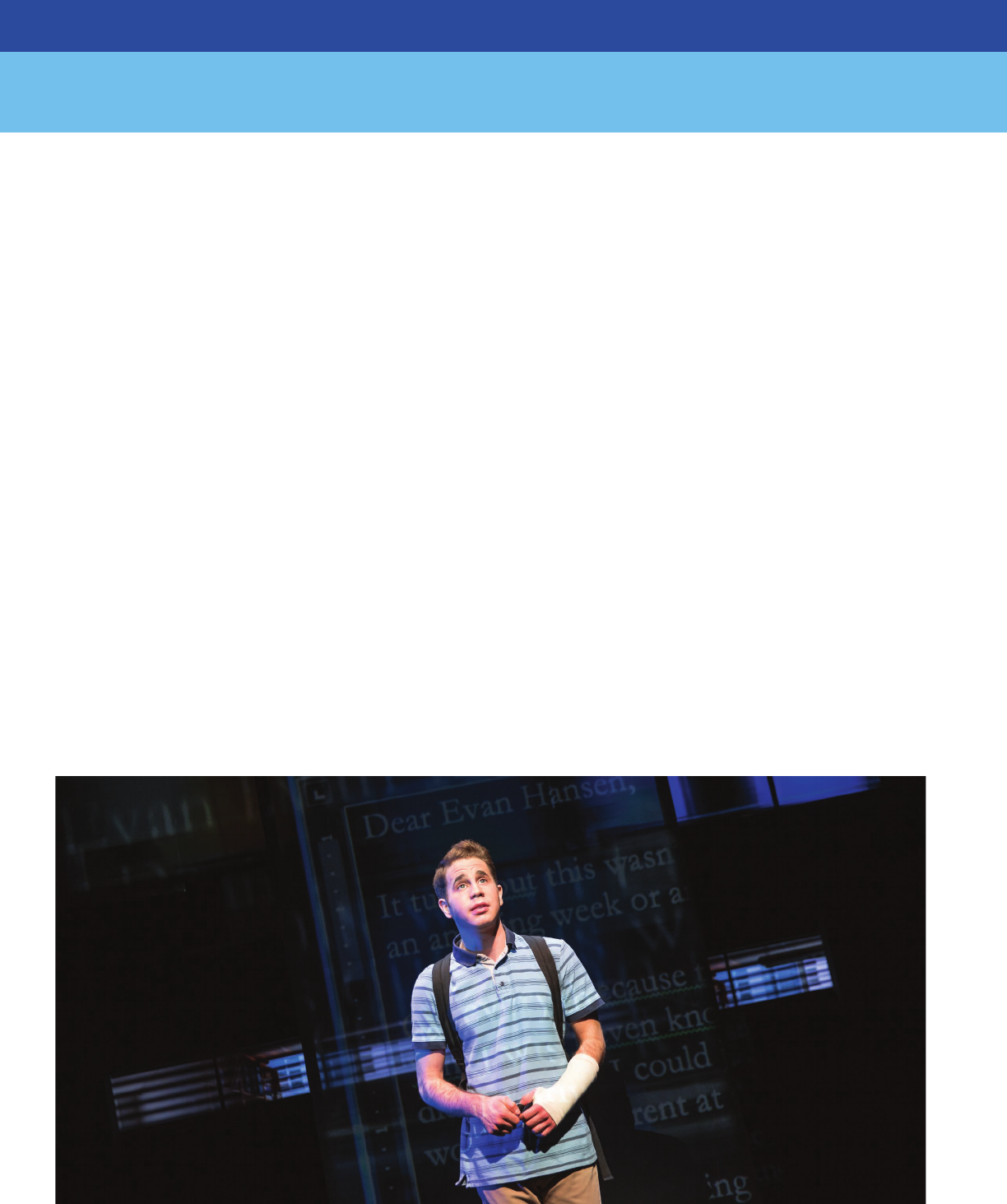
Ben Platt as Evan Hansen (Original Broadway Cast)
For Common Core State Standards see page 33.
CHARACTER JOURNEY:
COMPARING “WAVING THROUGH A WINDOW”
AND “YOU WILL BE FOUND”
YOU WILL BE FOUND
(First stanza and chorus)
HAVE YOU EVER FELT LIKE NOBODY WAS THERE?
HAVE YOU EVER FELT FORGOTTEN IN THE MIDDLE OF
NOWHERE?
HAVE YOU EVER FELT LIKE YOU COULD DISAPPEAR?
LIKE YOU COULD FALL, AND NO ONE WOULD HEAR
SO MAYBE LET THAT FEELING WASH AWAY
MAYBE THERE’S A REASON TO BELIEVE YOU’LL BE OK
’CAUSE WHEN YOU DON’T FEEL STRONG ENOUGH TO STAND
YOU CAN REACH, REACH OUT YOUR HAND
OH, SOMEONE WILL COME RUNNIN’
AND I KNOW THEY’LL TAKE YOU HOME
EVEN WHEN THE DARK COMES CRASHIN’ THROUGH
WHEN YOU NEED A FRIEND TO CARRY YOU
AND WHEN YOU’RE BROKEN ON THE GROUND
YOU WILL BE FOUND
SO LET THE SUN COME STREAMIN’ IN
’CAUSE YOU’LL REACH UP AND YOU’LL RISE AGAIN
LIFT YOUR HEAD AND LOOK AROUND
YOU WILL BE FOUND
YOU WILL BE FOUND
YOU WILL BE FOUND
YOU WILL BE FOUND
YOU WILL BE FOUND
WRITE: Examine the rst stanza/chorus of “You Will Be Found,” the nale to Act 1, and compare the lyrics to those in
“Waving Through a Window.” Has Evan changed? If so, how? How do Pasek and Paul use the continuity of metaphors and
symbolism to show Evan’s emotional journey throughout the rst act of the musical? Consider the audiences of each song —
to whom is Evan singing?
EXAMINE SONGS
ACTIVITY
21
COMPARE MUSIC & LYRICS
For Common Core State Standards see page 33.

22
Ben Platt as Evan Hansen, and Laura Dreyfuss as Zoe
Murphy (Original Broadway Cast)
Scene begins
Evan, alone.
EVAN
I’m not doing this. I’m done.
CONNOR
You can’t just stop now.
And Connor is there.
EVAN
I don’t think I can live with this anymore.
CONNOR
What about my parents?
EVAN
No more emails.
CONNOR
How can you do this to them?
EVAN
No more Connor Project. No more orchard.
CONNOR
After everything they’ve done for you? ey need you.
EVAN
Need me for what? To keep lying to them?
CONNOR
at lie is the only thing that’s keeping them together.
EVAN
at’s not true.
CONNOR
Oh really? ey seemed like a pretty happy family when
you met them?
EVAN
I don’t want to lie anymore.
CONNOR
And what about Zoe?
EVAN
Zoe said, she just … she wants me.
CONNOR
Right.
EVAN
She likes me for who I am.
CONNOR
Except you didn’t happen to mention that everything
you’ve told her, it’s all been one big fucking lie, did you?
Evan says nothing.
Oh. You left that part out.
EVAN
So then, what if … what if I did tell her the truth?
CONNOR
She’ll hate you.
EVAN
Maybe she would understand. Maybe everyone would
understand.
CONNOR
Everyone will hate you.
DISCUSS:
What dramatic conceit does book writer Steven Levenson use to
present this conict? What does this conversation reveal to us?
honesty
1. a : fairness and straightforwardness of conduct
b : adherence to the facts : sincerity
DISCUSS SCENE DIALOGUE
ACTIVITY
Review the final conversation between Evan and
Connor at the end of the second act.
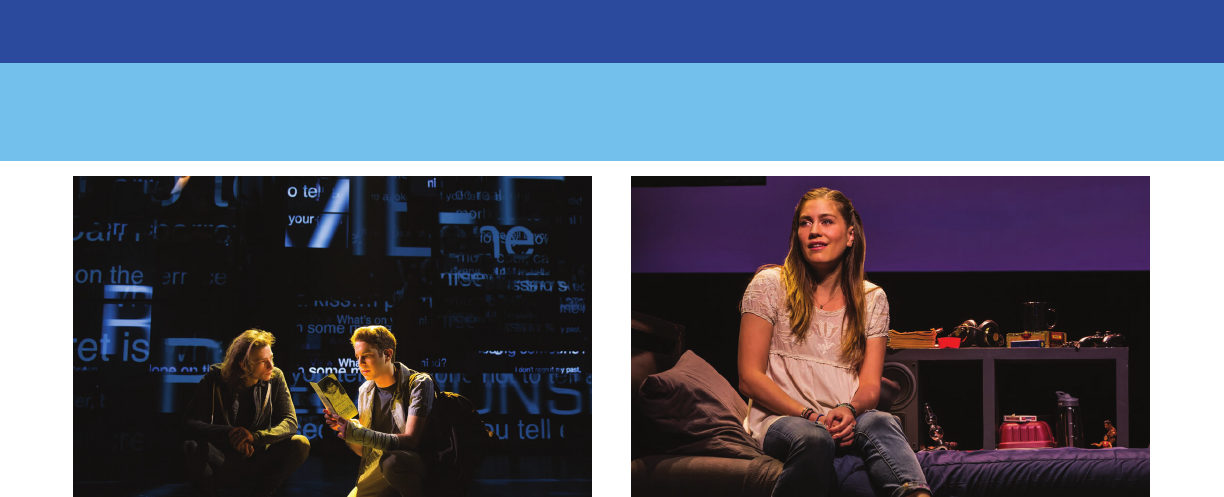
EVAN
Not if I can just, if I can explain it, you know?
CONNOR
You’ll go right back to where you started. No friends.
EVAN
I want to be done/ with this.
CONNOR
/ Nobody. Nothing. Alone.
EVAN
I’m ready to be done with it.
CONNOR
If you really believe that, then why are you standing
here, talking to yourself? Again?
Beat.
CONNOR (cont’d)
You think you’re going to turn around all of a sudden
and start telling everyone the truth?
You can’t even tell yourself the truth.
EVAN
What are you talking about?
CONNOR
How did you break your arm?
A pall comes over Evan.
How did you break your arm, Evan?
EVAN
I fell.
CONNOR
Really? Is that what happened?
EVAN (less and less condent)
I was, I lost my grip and I … I fell.
CONNOR
Did you fall? Or did you let go?
Beat. MUSIC IN.
You can get rid of me whenever you want. You can get
rid of all of it. e Connor Project.
e orchard. But then all that you’re going to be left
with is … you.
For Forever (Reprise)
CONNOR
END OF MAY OR EARLY JUNE
THIS PICTURE PERFECT AFTERNOON
WE SHARE.
DRIVE THE WINDING COUNTRY ROAD
GRAB A SCOOP AT “A LA MODE”
AND THEN WE’RE THERE …
CONNOR
ink about it.
Evan stands there for a moment, lost.
He makes a decision.
Lights shift and Evan and Alana are in their bedrooms,
online.
Connor is gone.
Mike Faist as Connor with Ben Platt as Evan (Original
Broadway Cast)
Laura Dreyfuss as Zoe Murphy (Original Broadway Cast)
EVAN & CONNOR, ACT II
For Common Core State Standards see page 33.
23
DISCUSS SCENE DIALOGUE
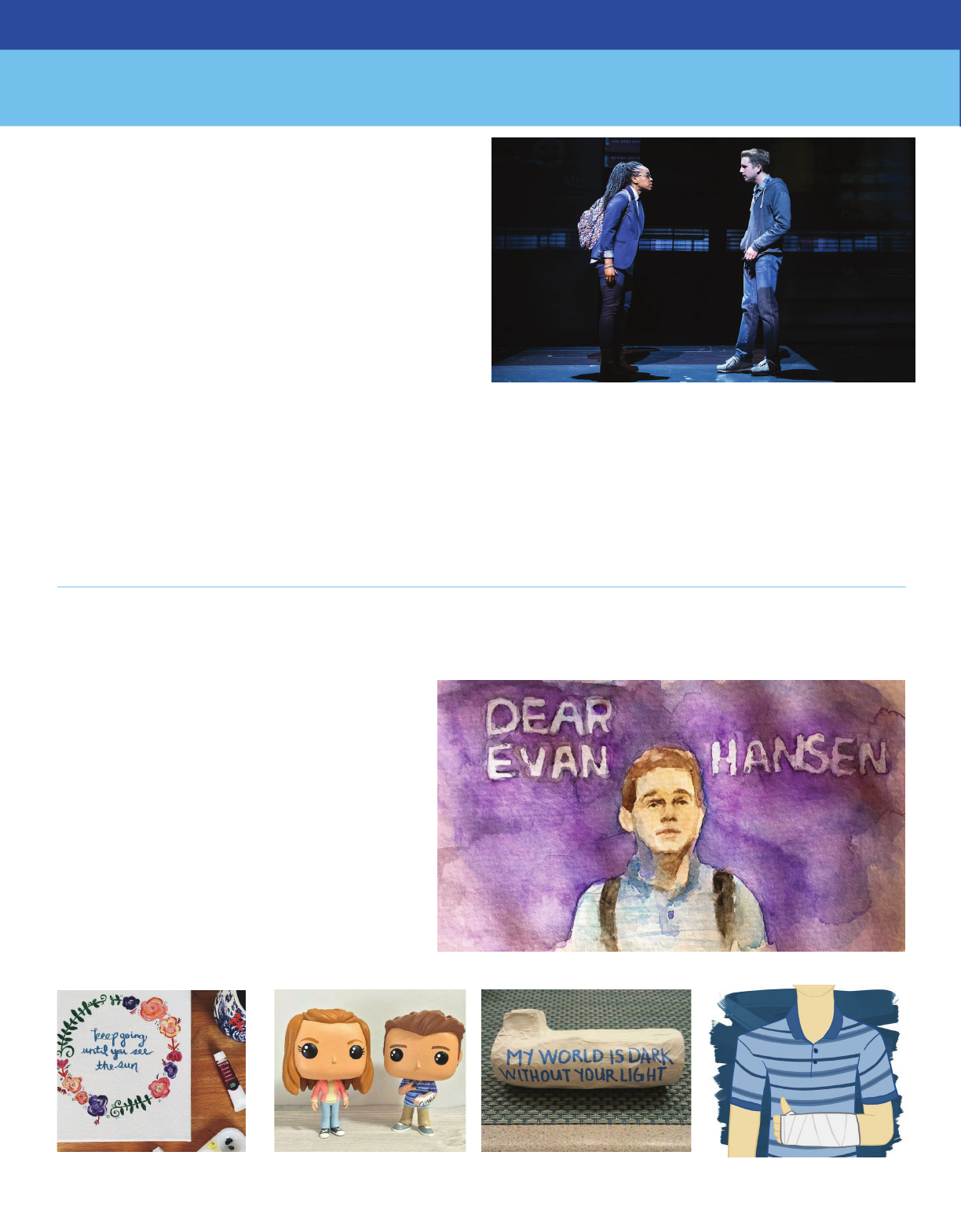
MAKING ART ABOUT ART
Artists take inspiration from all of their life experiences, including other art forms.
Dear Evan Hansen has inspired a tremendous
outpouring of fan art, some of which was featured in
our music video for “Waving Through a Window” (visit
Dear Evan Hansen’s official YouTube channel to watch
the video).
CREATE: How do the music, story, and emotions
of Dear Evan Hansen inspire you artistically? Using any
medium you like, create a piece of art that captures the
most memorable moment of the play for you. Will you draw,
paint, sculpt, make a collage or a lm, write a song…?
We hope you will share your creations with us! If you
feel so inspired, please tag us @dearevanhansen
#dearevanhansen
24
TAKE ACTION
In Dear Evan Hansen, Evan, Alana and Jared become
activists, developing a campaign to raise awareness about
suicide and promote suicide prevention within their school
and community. Some of the actions they take include:
• Creating and displaying awareness posters at school
• Selling awareness-raising buttons
• Developing a social media campaign
• Speaking at a student assembly
• Launching a Kickstarter fundraising campaign
DISCUSS: Together as a class, discuss some of the
ways in which they take action. Now discuss what causes are
important to you. Do you unite behind a single cause or are
there many individual interests? What are some of the actions
you can take to be a changemaker around an issue that is
important to you?
CREATE: Think specically about an issue that is
important to you and develop a plan of action. What campaign
would you propose to raise awareness? How might you
volunteer your time? What might you be able do on a personal
one-to-one level? How will you engage other friends and
members of your community?
Kristolyn Lloyd as Alana Beck with Ben Platt as Evan Hansen
(Original Broadway Cast)
TAK E ACTI O N & B E C R EATIVE
ACTIVITY
See more at dearevanhansenofcial.tumblr.com
For Common Core State Standards see page 33.

TAK E ACTI O N & B E C R EATIVE
For Common Core State Standards see page 33.
Q: How did you rst become aware of Dear Evan
Hansen?
A: I rst became aware of Dear Evan Hansen when it
was playing Off-Broadway. I love the theater. I studied
theater performance in college, so I try to stay in the
loop of what’s on stage. At that time, I was working on
Post It Forward, which is a program I had developed
and launched at Tumblr that touches on a few of the
themes in Dear Evan Hansen. It just so happens that
the PR agency I was working with was also working on
Dear Evan Hansen. They said, “This show and Post It
Forward are spiritual soul mates. You have to see it.” So
I went to see it and was completely wowed and amazed
by how beautiful it was and how much it resonated with me personally
because of its themes, which are important to me in both my life and
my work.
That same PR agency was kind enough to set up meeting for me with
Stacey Mindich, the producer of Dear Evan Hansen. So I went over to
her ofce and had an awesome chat about the show and what I was
working on and social media and social media for Dear Evan Hansen
and how they could be tapping into that community. At the end of that
amazing meeting, she said, “You know we have this Digital Board if
you want to think about being a part of it.” She probably hadn’t even
nished the sentence before I was like, “Oh, my god, yes!“ It really is
for me so funny because it’s so many of the interests that I’ve had in
my life for a long time: theater and connection over social media and
themes of mental health awareness, and they all converged into one.
So I get to play a tiny, tiny little part in the story of this production and
that’s really exciting for me.
Q: Can you tell me a bit more about Post It Forward? What is it
exactly?
A: Post It Forward is a community hub on Tumblr that was created
to give a safe space for conversation sharing around a myriad of
issues that fall under what we call mental and emotional well-being.
So this can be anything on the spectrum that someone could be
dealing with, whether it is bullying or self-harm or eating disorders or
LGBT issues. There is a lot happening in young people’s lives and we
really just wanted to create a place where people could talk and share
and nd community and support each other around these issues.
Q: How did it start? What was the impetus for Post It Forward?
A: It’s something that we’ve been thinking about for a few years and
I think we’ve been taking small steps toward guring out how to best
help support this community.
For many years, Tumblr as a platform has done a lot to try to help
catch people at moments of intervention. We’ve tested out putting
PSAs on the site so that if you are searching for a particular term that
falls into this spectrum, a PSA pops up that says, “Hey. Is everything
OK? How can we help you?” and directs you to helplines such as the
Crisis Text Line or to a center where you can actually
nd the support that you need. But we felt that we
could do more. We kept feeling like we shouldn’t only
be talking about these issues of mental health in the
aftermath of when something really scary has happened,
when everybody is saying, “What could have been
done?” Rather, we wanted to bring the conversation
to the forefront — completely devoid of any tragedy
— in the hopes that by talking about these issues and
destigmatizing them little by little we can start to break
down some of the shame people experience.
In addition, we have a lot of amazing content on Tumblr
that is very supportive, including people sharing their
personal experiences around mental illness. It is
people, on their own, connecting with other people — sometimes in
the same state or sometimes a different country — going that extra
step of saying, “Hey, I’ve been there. I can help you. Let’s share our
stories together.” We also have a lot of amazing resources on Tumblr
in regards to nonprots who are using the platform in a similar way.
So part of creating Post It Forward was realizing that there was all this
amazing stuff organically happening, and that we needed to gather
it into a hub and put it in one place where we could really amplify the
voices of our community. So that’s what we built Post It Forward to
achieve. To bring together our experts in the community, our amazing
users who are already doing this great work, our celebrity partners,
who have their own stories to tell and to open it up to say “Hey, this is
a safe space to share.” And more importantly, to bring home the idea
that by sharing your experience, and what you’ve been through, you
might be helping somebody else.
The response has been so positive and so overwhelming. I’ve had the
opportunity of meeting many, many of our users who have become
Post It Forward superstars and have gone above and beyond to
reach out to other people. They create their own original content and
come into our ofce for our mental health seminars and get certied
to become Crisis Text Line Ambassadors. They have really just taken
this beyond our wildest expectations and it’s so awesome to see them
doing that in service of other people who, like them, are maybe just
going through a hard time.
Q: What advice would you give to young people who want
to become activists in this kind of way — whether it is around
this issue or another issue that might be important to them —
and how might they be able to use the Internet as a platform to
create change?
A: I can’t understate enough the power of your own voice and your
own story. Whether it is on social media and the Internet or whether
it is in the halls of your school. Your story and your perspective —
whether you’ve been through a certain experience or whether you
just have seen something that you feel you want to speak out on.
I’ve seen rsthand the power of sharing your personal story and how
that can impact someone. Every voice matters. No one person is too
small. Use whatever tools you have at you disposal to make yourself
heard. There’s real power in it!
KATHERINE BARNA, FORMER HEAD OF COMMUNICATIONS AT TUMBLR (NOW VP OF
COMMUNICATIONS AT AWESOMENESS), ON THE SYNERGY BETWEEN HER WORK
AND
DEAR EVAN HANSEN
EMPOWER: INSIDE POST IT FORWARD
25

THE POWER OF POSITIVE THINKING
At the beginning of the show, Evan has an assignment: to
write an inspirational letter to himself.
“Dear Evan Hansen,
Today is going to be a great day and here’s why …”
Much has been written about the power of positive thinking,
the benefits of an optimistic outlook, and the value of self
pep talks. Together these techniques can:
• Relieve stress and anxiety
• Reshape attitudes
• Increase self-esteem
• Influence behavior
• Impact goal achievement
• Improve overall heath
WRITE: Write an inspirational letter to yourself.
Dear me,
“This is going to be a great [day/week/year] and here’s why …”
What are you most looking forward to? What, if anything, do
you hope to achieve? What are the challenges you might
face? How will you work to overcome those hurdles?
OUTSIDERS
Literature, both classic and contemporary, is filled with
“outsiders” — characters who, like Evan, feel isolated and
struggle to connect. Although each character has his/
her own unique backstory and challenges, one can find
commonalities between them.
WRITE: Choose an “outsider” from another book you
have read or are currently reading. Write a comparative essay
showing the similarities and differences between that character
and Evan. How do their emotions/choices/journeys parallel
one another and where do they diverge? What impact does
each have on other characters in their respective stories?
Some suggested character comparisons.
• Laura from The Glass Menagerie by Tennessee Williams
• Holden Cauleld from Catcher in the Rye by J.D. Salinger
• Charlie from The Perks of Being a Wallower by Stephen
Chbosky
• Christopher from The Curious Incident of the Dog in the
Night-Time by Mark Haddon
• Oscar from The Brief Wondrous Life of Oscar Wao by Junot
Diaz
• Eleanor from Eleanor and Park by Rainbow Rowell
• Aza Holmes in Turtles All the Way Down by John Green
• Greg Gaines from Me and Earl and the Dying Girl by
Jesse Andrews
FLAWED HERO/DECEPTION
Evan is a flawed hero. As a class, discuss the characteristics of
a flawed hero. How does the presence of a flawed hero serve
the overall storytelling of a fictional work? Why is it important
for protagonists to have character flaws? How do authors
go about creating protagonists who are likable despite their
flaws?
Many times, flawed heroes — like Evan — lie to gain status
with others and/or a sense of belonging. Sometimes these
lies stem from uncorrected misconceptions or omissions of
the truth and grow into greater deceptions. This convention
appears not only in literature but also many modern-day films.
WRITE: Choose a book/movie you have recently read/
seen in which lying/deception is a central theme. Compare it
to Dear Evan Hansen. How does the lie begin? What are the
character’s motives and what are results?
Some suggested character comparisons.
• Gatsby from The Great Gatsby
• Tom from The Talented Mr. Ripley
• Huck from The Adventures of Huckleberry Finn by Mark
Twain
• Olive from Easy A
LITERARY COMPARISONS
26
WRITE TO INSPIRE
ACTIVITY
For Common Core State Standards see page 33.

WRITE TO INSPIRE
27
In Dear Evan Hansen, the title character struggles with social
interaction and maintaining relationships, isolates himself, and
fears being judged by others. Although Evan’s specific problem
is not named in the play, these are classic signs of social anxiety
disorder, a mental health disorder that affects many young
people, usually beginning during the early teen years.
Also in the play, the character Connor Murphy takes his own life.
Before his suicide, he is depicted as angry, oppositional, and
isolated, which may be seen in young people struggling with
depression. Self-harm, suicide attempts, and completed suicide
are also strongly linked to adolescent mood disorders such as
depression.
WHAT IS SOCIAL ANXIETY?
In the teen years, young people start being more aware of what
other people think. There are “right” things to wear, or say, or do —
and things that teens shouldn’t do that could be embarrassing or
weird. Some feel so worried about what others are thinking about
them that it starts to impact negatively on their everyday lives. This
kind of worry is called social anxiety disorder.
Kids with social anxiety disorder aren’t just nervous when they
are at parties or giving a speech in class. Even answering a
question in class can feel extremely scary; some kids worry they
will humiliate themselves simply by eating in the school cafeteria
or walking into a room. That’s because kids with social anxiety
fear they might do something embarrassing or offensive, and it will
make others judge or reject them.
WHAT IS DEPRESSION?
A young person with depression experiences persistent, intense
feelings of sadness, hopelessness, and irritability that make it
hard to function day to day. We don’t know exactly how or why
depression develops, but it’s not usually caused by bad things
happening.
Depression is called an “internalizing disorder,” which means that
it primarily affects a young person’s emotional life rather than their
behavior. Because of this, it can take a while for others to recognize
it — or for a young person to realize that his/her thinking, and
emotional responses, is troubled. Adolescent depression is more
common than some people think. According to some statistics,
more than 12 percent of teens ages 15 and 16 struggle with
depression. For teens ages 17 and 18 it jumps to more than
15 percent.
HOW CAN YOU SPOT SOCIAL ANXIETY AND DEPRESSION?
Young people with social anxiety disorder often think their anxiety
is obvious, which can create more anxiety. But, in actuality, other
people might not recognize it, because a lot of the symptoms of
anxiety are happening under the surface. Panicked thoughts,
a racing heart, or an upset stomach aren’t apparent from the
outside. For other kids, however, anxiety can produce outward
signs such as anger or aggression.
Similarly, since adolescents are often moody, it can be difcult to
recognize when someone has become depressed. The rst sign
people tend to notice is withdrawal from friends, or when someone
stops doing things he/she usually likes to do.
These are some of the most prominent signs of depression in teens:
THE STIGMA OF MENTAL HEALTH DISORDERS
Many people don’t want to believe that young people can have
mental health disorders such as depression and anxiety. They
say that young people with serious mental health problems are
just going through regular growing pains. As we see in Dear
Evan Hansen, the emotional problems that young people face
are very real.
Adolescent psychiatric disorders are common (one in ve children
and teens struggle with a diagnosable disorder), and have real
biological and environmental causes. But the denial of these facts
leads struggling teens and their families to feelings of shame
and fear of judgment. Millions of children and teens don’t seek
treatment because of this stigma, but it is vital to be open and ask
for help.
HOW CAN TEENS GET HELP IF THEY ARE ANXIOUS
OR DEPRESSED?
Te en s wh o th in k th ey n ee d he lp w it h an e mo ti on al or m en ta l he al th
issue might not know how to ask for help. If they are very anxious, it
might be embarrassing for them to admit that things that seem easy
for other people are very hard for them. If they are depressed, they
may worry that others won’t understand and will tell them to “snap
out of it” — or that family and friends will be disappointed.
But parents, teachers, and friends can be more sympathetic and
less judgmental than teens imagine. First, however, they need to
know how a young person is feeling. The sooner a teen asks for
help, the sooner they will start feeling better.
UNDERSTANDING SOCIAL ANXIETY
• Persistent sadness or irritability
• Feeling worthless, or hopeless about the future
• Diminished interest in most activities, especially things they used
to enjoy
• Changes in eating or sleeping patterns
• Low energy and motivation
• Decline in academic performance
• Decreased ability to think or concentrate
• Thinking about suicide or death
SOME INSIGHTS FROM OUR PARTNERS AT THE CHILD MIND INSTITUTE

28
childmind.org
The Child Mind
Institute is an
independent, national
nonprot dedicated to
transforming the lives of
children and families struggling with mental
health and learning disorders. Their teams
work every day to deliver the highest
standards of care, advance the science
of the developing brain, and empower
parents, professionals, and policymakers
to support children when and where they
need it most.
The Child Mind Institute is dedicated to
helping children reach their full potential
in school and in life and is driven to create
a brighter future for children through the
following three commitments:
• Give children access to the best, most
effective treatments
• Advance the science of the developing
brain to improve diagnosis
• Provide information that empowers
families and communities to get help
The organization does not accept funding
from the pharmaceutical industry. All
resources are free.
Connect with Child Mind Institute:
ChildMindInstitute
ChildMindDotOrg
company/Child-Mind-Institute
crisistextline.org
When a young woman texted
DoSomething.org with a heartbreaking
cry for help, the organization responded
by opening a nationwide Crisis Text Line
for people in pain. Nearly 29 million text
messages later, the organization is using
the privacy and power of text messaging
to help people handle addiction, suicidal
thoughts, eating disorders, sexual abuse,
and more. But there’s an even bigger win:
The anonymous data collected by text is
teaching us when crises are most likely to
happen — and helping schools and law
enforcement to prepare for them.
Tex t th e Cr is is Te xt L in e at 74 1- 74 1.
thejedfoundation.org
JED is a nonprot
that exists to protect
emotional health and
prevent suicide for our
nation’s teens and young adults. JED
partners with high schools and colleges to
strengthen their mental health, substance
abuse prevention and suicide prevention
programs and systems; equips teens and
young adults with the skills and knowledge
to help themselves and each other; and
encourages community awareness,
understanding, and action for young adult
mental health.
Learn more about JED programs: JED
Campus (jedcampus.org), ULifeline
(ulifeline.org), Half of Us (halfofus.com),
Love Is Louder (loveislouder.com) and
Set to Go (settogo.org).
Connect with JED:
Email: jedfoundation.org/email
jedfoundation
company/the-jed-foundation
thetrevorproject.org
Founded in 1998 by the creators of the
Academy Award
®
–winning short lm
Trevor, The Trevor Project is the leading
national organization providing crisis
intervention and suicide prevention
services to lesbian, gay, bisexual,
transgender, and questioning (LGBTQ)
young people ages 13 to 24.
Every day, The Trevor Project saves
young lives through its accredited, free,
and condential phone, instant message,
and text messaging crisis intervention
services. A leader and innovator in
suicide prevention, The Trevor Project
offers the largest safe social networking
community for LGBTQ youth, best practice
suicide prevention, educational trainings,
resources for youth and adults, and
advocacy initiatives.
Connect with The Trevor Project:
TheTrevorProject
trevorproject
bornthisway.foundation
Led by Lady Gaga and her mother, Cynthia
Germanotta, Born This Way Foundation
was founded in 2012 to support the
wellness of young people and empower
them to create a kinder and braver world.
To achieve these goals, Born This Way
Foundation leverages rigorous academic
research and authentic partnerships in
order to provide young people with kinder
communities, improved mental health
resources, and more positive environments
— online and ofine.
Connect with Born This Way Foundation:
bornthiswayfoundation
BTWFoundation
DON’T BE AFRAID TO ASK FOR HELP
HOTLINES
FOR HELP
If you or someone you know is having
thoughts of suicide, don’t wait—
• Tell a t ru st ed ad ul t (p ar en t, te ac he r,
school nurse, coach, pediatrician,
etc.)
• Call an anonymous hotline
The National Suicide Prevention
Lifeline at 1-800-273-8255 (TALK)
The Trevor Lifeline at
1-866-488-7386
1.800.LIFENET (543-3638)
Tex t th e Cr is is Te xt L in e at 74 1- 74 1

29
HELP A FRIEND IN NEED
HERE ARE POTENTIAL WARNING SIGNS ON
SOCIAL MEDIA THAT A FRIEND MIGHT BE IN
EMOTIONAL DISTRESS AND NEED YOUR HELP,
FROM THE JED FOUNDATION (JED), A NONPROFIT
THAT EXISTS TO PROTECT EMOTIONAL HEALTH
AND PREVENT SUICIDE FOR OUR NATION’S TEENS
AND YOUNG ADULTS.
Be aware of statuses/posts, messages, photos, videos, links,
comments, or hashtags that include the following themes:
• Feeling alone, hopeless, isolated, useless, or a burden to
others: “I feel like I’m in a black hole”; “I don’t want to get out
of bed...ever”; “Leave me alone”; “I can’t do anything”
• Showing irritability and hostility that is out of character: “I hate
everyone”; “F*@K the world”
• Showing impulsive behaviors: such as driving recklessly, a
signicant change in, and especially increase in, substance
use, or taking other risks
• Insomnia posts: “3am again and no sleep”
• Withdrawal from everyday activities: “Missed another chem
lab — I’m such a waste”; “Another day in bed under the
covers”
• Use of negative
emoticons: for example,
repeatedly using
emoticons that suggest
someone is feeling down
or thinking about using a
tool to hurt themselves.
• Use of concerning hashtags: #depressed #lonely
#whenimgone #noonecares #suicidal #selfharm #hatemyself
#alone #sad #lost #worthless #neverenough #givingup
Currently, when someone searches for a hashtag indicative
of self-harm (for example, “#cutting”) on Instagram, a content
advisory warning pop-up will appear. People have the option
to select “Learn More” before viewing any posts.
• Following activity: On either Facebook’s News Feed, or
Instagram’s Following Activity, you can see the accounts
and posts people start to follow. If you notice a friend liking
or following feeds or posts that promote negative behaviors,
even if they aren’t sharing concerning content themselves,
that may serve as a warning sign that they are engaging with
troubling messages or communities.
• Trust your instincts:
If you see someone
posting messages,
photos, videos, links,
comments, or hashtags
that suggest the person is in emotional distress, you should
reach out and get them the help they may need.
POSSIBLE WARNING SIGNS OF
EMOTIONAL DISTRESS
If you see someone posting distressing content on social media, or if they are behaving dramatically differently
than usual, it may signal that this person needs help. If you have a gut feeling that something is not right, you
should act on it.
SAD GUILTY DOWN LOST
IRRITATED BAD ALONE DEPRESSED
I can’t handle any
of this

30
If you have a friend who seems to be struggling with an issue
that may be more serious than they can handle, there is a lot
that you can do to support them.
Reach out — pick up the phone, swing by their place, walk with
them to do errands, let them know they are not alone in feeling
this way and that it’s OK to ask for help. Be clear and direct,
and do not use hints such as liking a post or replying with an
emoticon, as these could be misinterpreted by the person
you’re trying to help.
Understanding that it can be tough to start this conversation,
here are some suggestions on how you can reach out:
– “I’m worried about you because you seem…” (e.g., sad,
withdrawn, etc.).
– Have examples ready such as, “It concerned me when you
said…” Be specic about what you noticed.
– “Do you want to talk about it?”; “What can I do to help?”
– If they say no, then you might say: “It’s OK if you don’t want
to talk to me, but it is important that you talk to someone.”
– Offer to help them connect with support.
While it can be hard, particularly on social media, to know if
someone is exaggerating, being sarcastic or being serious, if
someone threatens to take their own life, you should always
take them seriously.
Here are some examples of things someone at risk of suicide
might post about:
• Suicide or wanting to die: “I want out”; “Everyone would be
better off without me”; “No one would care if I were gone”;
“There’s no reason to live”
• Intense and urgent emotional despair or intense guilt or
shame, feeling trapped: “I can’t take it [the pain] anymore”;
“There is no way out”; “I’m done”; “I’m so sorry for all the
trouble I’ve caused everyone”
• Rage or seeking revenge: “I’ll show you all”; “She’ll be sorry”
• Saying goodbyes, giving away personal possessions: “I’ll
miss you all”; “You won’t have to worry about me anymore”
• Glorifying or glamorizing death, or making death seem
heroic: “Death is beautiful”
• Where/how to get potentially lethal means, like access to
pills or weapons
HELP A FRIEND IN NEED
HOW TO HELP A FRIEND IN NEED
WARNING SIGNS THAT SOMEONE MAY NEED
URGENT HELP OR MAY BE AT RISK OF SUICIDE
NEVER BE AFRAID TO GIVE YOUR FRIEND A
CALL, PAY A VISIT, OR SEND THEM A FACEBOOK
MESSAGE TO LET THEM KNOW YOU ARE
CONCERNED, AND OFFER TO HELP CONNECT
THEM WITH ANY EXTRA SUPPORT NEEDED.
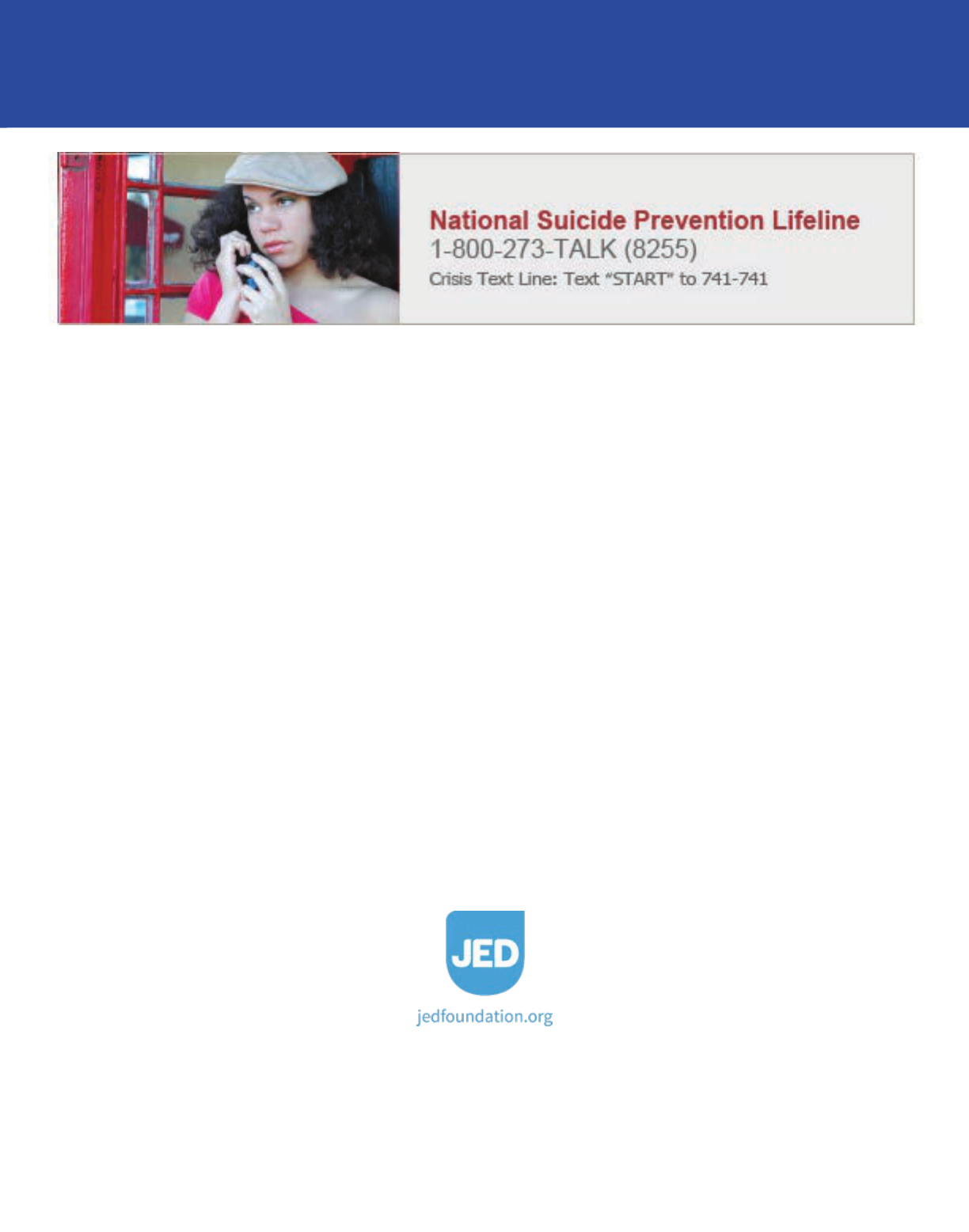
31
BROUGHT TO YOU BY:
FOR MORE INFORMATION ABOUT MENTAL HEALTH AND HOW TO HELP YOURSELF OR A FRIEND, VISIT:
www.jedfoundation.org
This guide, while evidence based, is for informational and educational purposes only and is not intended to constitute medical advice
or be a substitute for professional diagnosis and treatment.
1. If someone is threatening their own life or someone else’s
life, this is an emergency. If you feel comfortable, you
should bring your friend to the emergency room. Or you call
911 or campus emergency services immediately. If it’s safe
to do so, stay with that person or do what you can to contact
them or nd someone to stay with them until help arrives.
2. You can use the following free, 24/7 national services any
time:
Crisis Text Line: Text “START” to 741-741 or call the
National Suicide Prevention Lifeline
1-800-273-TALK (8255).
REMEMBER TO:
• Listen without judgment, assumptions, or interruptions. Let
them know that you believe what they are saying and take
them seriously
• Know your limits and do not place yourself in physical danger
— the best way to help is to connect your friend to a mental
health professional.
HELP A FRIEND IN NEED
HOW TO HELP A FRIEND IN URGENT NEED OR
WHO MAY BE AT RISK OF SUICIDE
NO MATTER WHAT, YOU SHOULDN’T BE EMBARRASSED OR WORRIED ABOUT OFFENDING OR
UPSETTING YOUR FRIEND. HELPING YOUR FRIEND MAY TAKE SOME COURAGE, BUT IT IS ALWAYS
WORTH THE EFFORT TO SUPPORT THEIR HEALTH AND SAFETY.

32
RESOURCES FOR TEACHERS & PARENTS
Dowd, Stephanie Psyd. “How To Help Your Depressed
Teenager.” Child Mind Institute. Childmind.org
Ehmke. Rachel. “How Using Social Media Affects
Teenagers.” Child Mind Institute. Childmind.org
Ehmke, Rachel. “Tips for Communicating With Your Teen.”
Child Mind Institute. Childmind.org
Foster, Brooke Lea. “Married to Their Smartphones.”
NYTimes.com. October 28, 2016.
Green, R. Kay. “The Social Media Effect: Are You Really
Who You Portray Online?” The Blog, HufngtonPost.com.
August 7, 2013.
Heitner, Devorah. “Rules for Social Media Created by
Kids.” NYTimes.com. January 5, 2017.
Lublin, Nancy. “How Data From Crisis Text Line Is Saving
Lives.” TEDWoman. May 2015,
CEO and founder of Crisis Text Line, Nancy Lublin is using
technology and data to help save lives. Crisis Text Line is free
24/7 support for those in crisis. Text START to 741741 from
anywhere in the USA to text with a trained crisis counselor.
McGrath, Keenan. “Your Facebook Life Doesn’t Fool Me.”
scarymommy.com
Price, Michael. “Alone in the Crowd: American Psychology
interview with Sherry Turkle.” apa.org. June 2011 Vol. 42,
No. 6 (print edition, page 26).
Steingard, MD, Ron J. “What are the Symptoms of
Depression in Teenagers?” Child Mind Institute.
Childmind.org
Stone. Zara. “Psychology of Facebook: The Facebook
Self vs. The Real Self.” www.chipchick.com. November 30,
2011.
Turkle, Sherry. “Connected, but Alone?” TEDTalk. TED.com.
April 3, 2012.
As we expect more from technology, do we expect less
from each other? Sherry Turkle studies how our devices
and online personas are redening human connection and
communication — and asks us to think deeply about the new
kinds of connection we want to have.
White, Thomas. “Why Social Media Isn’t Social.” The Blog,
HufngtonPost.com. September 4, 2013.
FOR ADDITIONAL READING AND REFERENCES ON SOME OF THE TOPICAL ISSUES
RAISED IN
DEAR EVAN HANSEN,
PLEASE VISIT THE FOLLOWING LINKS:
Fan art

33
EDUCATION STANDARDS FOR LESSONS
ANALYZE CHOICES:
MAKING CHOICES
(PG. 17)
Common Core State Standards
Grades 9-10:
• CCSS.ELA-LITERACY.W.9-10.1
Write arguments to support claims in an
analysis of substantive topics or texts, using
valid reasoning and relevant and sufcient
evidence.
Grades 11-12:
• CCSS.ELA-LITERACY.W.11-12.1
Write arguments to support claims in an
analysis of substantive topics or texts, using
valid reasoning and relevant and sufcient
evidence.
WRITE TO INSPIRE: THE POWER
OF POSITIVE THINKING
(PG. 26)
Framework for 21
st
Century Learning: Life and
Career Skills
• Set goals with tangible and intangible
success criteria
• Set and meet goals, even in the face of
obstacles and competing pressure
Framework for 21
st
Century Learning: Health
Literacy
• Understanding preventive physical and
mental health measures, including proper
diet, nutrition, exercise, risk avoidance, and
stress reduction
TAKE ACTION AND BE CREATIVE:
MAKING ART ABOUT ART
(PG. 24)
National Core Arts Standards
• VA:Cr1.2.Ia: Shape an artistic investigation
of an aspect of present-day life using a
contemporary practice of art or design.
• VA:Cr1.2.IIa: Choose from a range of
materials and methods of traditional and
contemporary artistic practices to plan works
of art and design.
• MU:Cr2.1.C.Ia: Assemble and organize
sounds or short musical ideas to create
initial expressions of selected experiences,
moods, images, or story lines.
• MA:Cr2.1.I: Apply aesthetic criteria in
developing, proposing, and rening artistic
ideas, plans, prototypes, and production
processes for media arts productions,
considering original inspirations, goals, and
presentation context.
REFLECT ON SOCIAL MEDIA:
THE DIGITAL EFFECT
(PG. 19)
Common Core State Standards
Grades 9-10:
• CCSS.ELA-LITERACY.W.9-10.2
Write informative/explanatory texts to
examine and convey complex ideas,
concepts, and information clearly and
accurately through the effective selection,
organization, and analysis of content.
Grades 11-12:
• CCSS.ELA-LITERACY.W.11-12.2
Write informative/explanatory texts to
examine and convey complex ideas,
concepts, and information clearly and
accurately through the effective selection,
organization, and analysis of content.
COMPARE MUSIC AND LYRICS
(PG. 20)
AND EXAMINE SONGS
(PG. 21)
AND CONSIDER CHARACTER AND
MUSIC: MUSIC
(PG. 18)
Common Core State Standards
Grades 9-10:
• CCSS.ELA-LITERACY.W.9-10.9
Draw evidence from literary or informational
texts to support analysis, reection, and
research.
• CCSS.ELA-LITERACY.L.9-10.5
Demonstrate understanding of gurative
language, word relationships, and nuances
in word meanings.
• CCSS.ELA-LITERACY.RL.9-10.4
Determine the meaning of words and
phrases as they are used in the text,
including gurative and connotative
meanings; analyze the cumulative impact of
specic word choices on meaning and tone
(e.g., how the language evokes a sense
of time and place; how it sets a formal or
informal tone).
Grades 11-12:
• CCSS.ELA-LITERACY.W.11-12.9
Draw evidence from literary or informational
texts to support analysis, reection, and
research.
• CCSS.ELA-LITERACY.L.11-12.5
Demonstrate understanding of gurative
language, word relationships, and nuances
in word meanings.
• CCSS.ELA-LITERACY.RL.11-12.4
Determine the meaning of words and
phrases as they are used in the text,
including gurative and connotative
meanings; analyze the impact of specic
word choices on meaning and tone,
including words with multiple meanings or
language that is particularly fresh, engaging,
or beautiful.
DISCUSS SCENE DIALOGUE
(PG. 22-23)
Common Core State Standards
Grades 9-10:
• CCSS.ELA-LITERACY.RL.9-10.3
Analyze how complex characters (e.g.,
those with multiple or conicting motivations)
develop over the course of a text, interact
with other characters, and advance the plot
or develop the theme.
• CCSS.ELA-LITERACY.RL.9-10.5
Analyze how an author’s choices concerning
how to structure a text, order events within
it (e.g., parallel plots), and manipulate time
(e.g., pacing, ashbacks) create such effects
as mystery, tension, or surprise.
Grades 11-12:
• CCSS.ELA-LITERACY.RL.11-12.3
Analyze the impact of the author’s choices
regarding how to develop and relate
elements of a story or drama (e.g., where
a story is set, how the action is ordered,
how the characters are introduced and
developed).
• CCSS.ELA-LITERACY.RL.11-12.5
Analyze how an author’s choices concerning
how to structure specic parts of a text (e.g.,
the choice of where to begin or end a story,
the choice to provide a comedic or tragic
resolution) contribute to its overall structure
and meaning as well as its aesthetic impact.
WRITE TO INSPIRE:
LITERARY COMPARISONS
(PG. 26)
Common Core State Standards
Grades 9-10:
• CCSS.ELA-LITERACY.W.9-10.1
Write arguments to support claims in an
analysis of substantive topics or texts, using
valid reasoning and relevant and sufcient
evidence.
• CCSS.ELA-LITERACY.W.9-10.9
Draw evidence from literary or informational
texts to support analysis, reection, and
research.
Grades 11-12:
• CCSS.ELA-LITERACY.W.11-12.1
Write arguments to support claims in an
analysis of substantive topics or texts, using
valid reasoning and relevant and sufcient
evidence.
• CCSS.ELA-LITERACY.W.11-12.9
Draw evidence from literary or informational
texts to support analysis, reection, and
research.
TAKE ACTION AND BE CREATIVE:
TAKE ACTION
(PG. 24)
Framework for 21
st
Century Learning: Creativity
and Innovation
• Use a wide range of idea creation
techniques (such as brainstorming)
• Elaborate, rene, analyze, and evaluate their
own ideas in order to improve and maximize
creative efforts
• Act on creative ideas to make a tangible and
useful contribution to the eld in which the
innovation will occur

#youwillbefound
Designed by
/DearEvanHansen @DearEvanHansen @dearevanhansen /dearevanhansenmusical dearevanhansenofcial
.tumblr.com
DEAR
EVAN
HANSEN
Ofcial Website dearevanhansen.com
Book By Steven Levenson (TCG Edition)
Available in Paperback and Kindle Edition
Cast Recording Available through Atlantic Records as
Streaming, MP3, Audio CD and on vinyl
Photography Matthew Murphy
The Dear Evan Hansen Ofcial Study Guide has been
compiled by Rachel Weinstein and Caitlin Clements.
